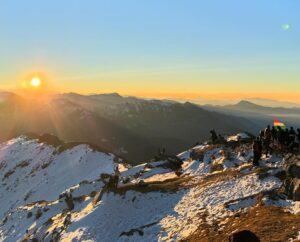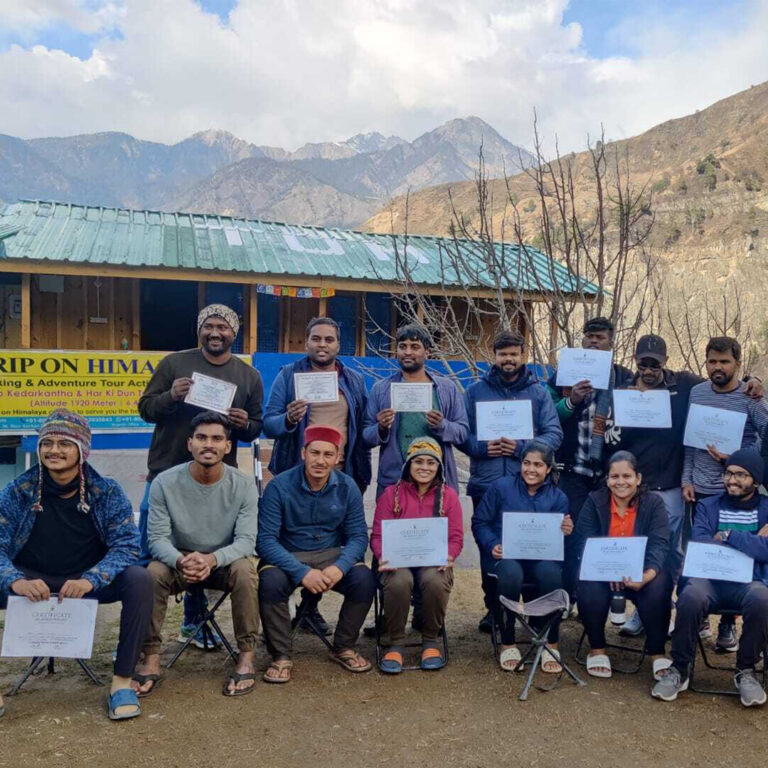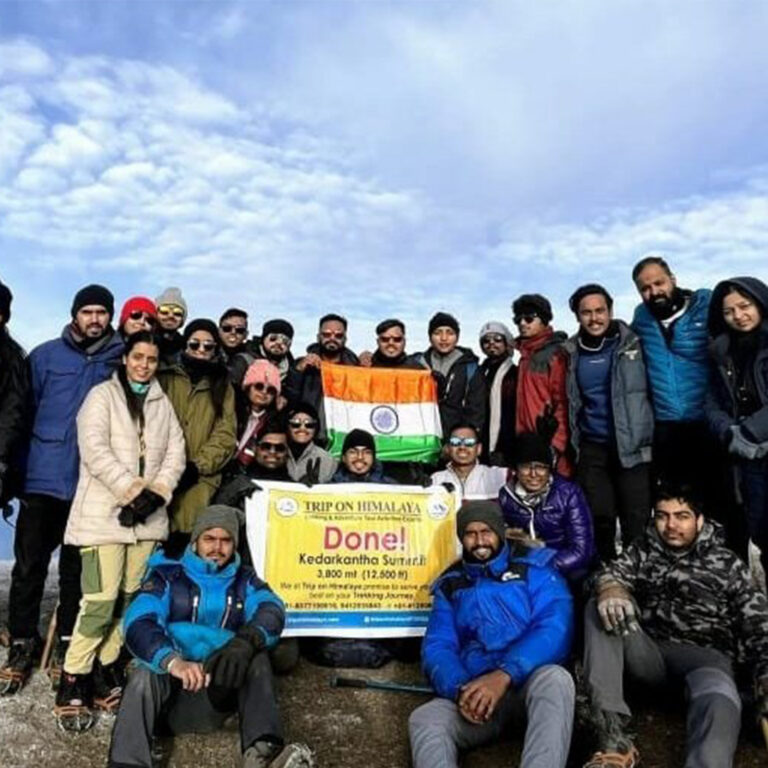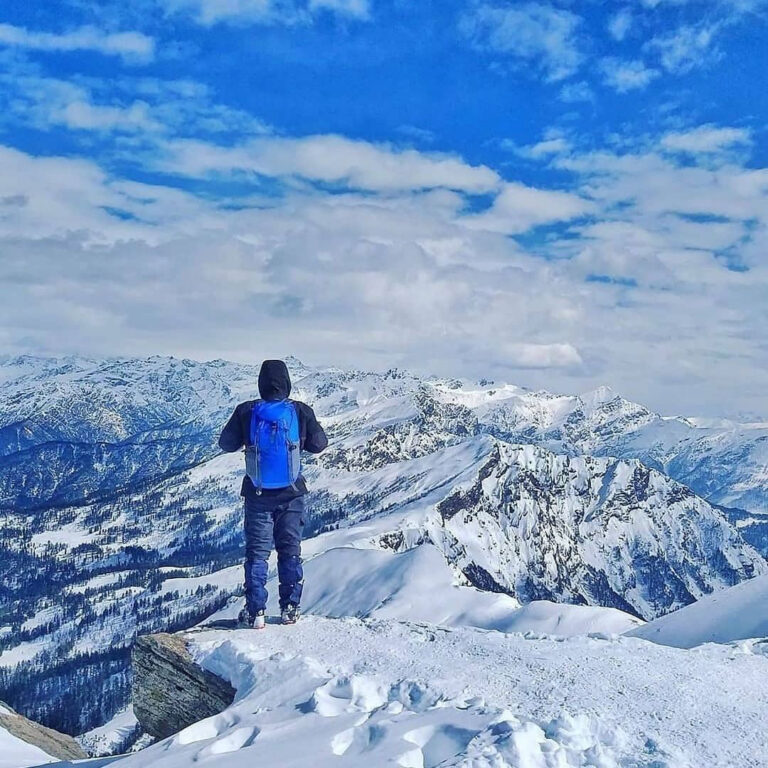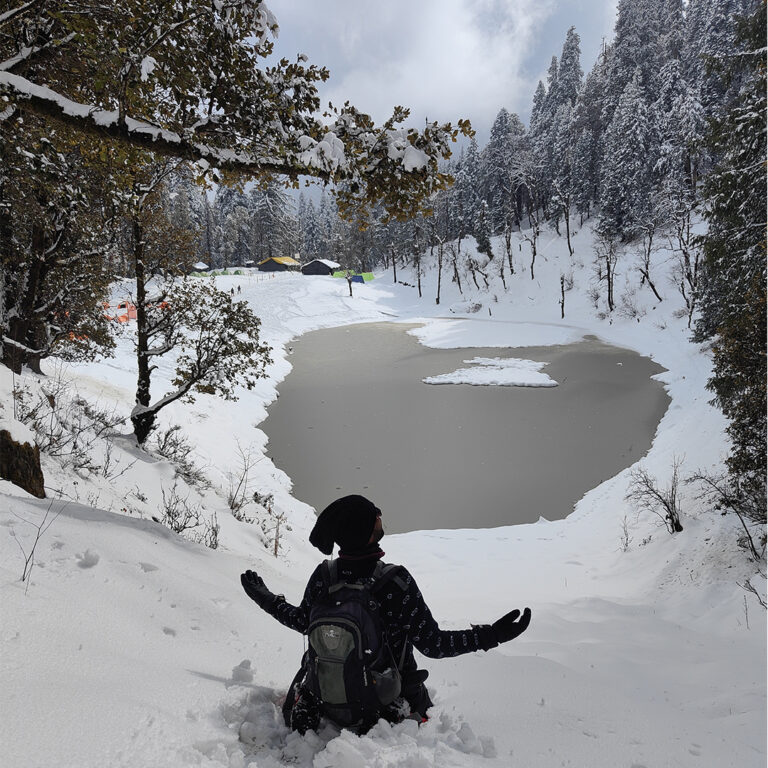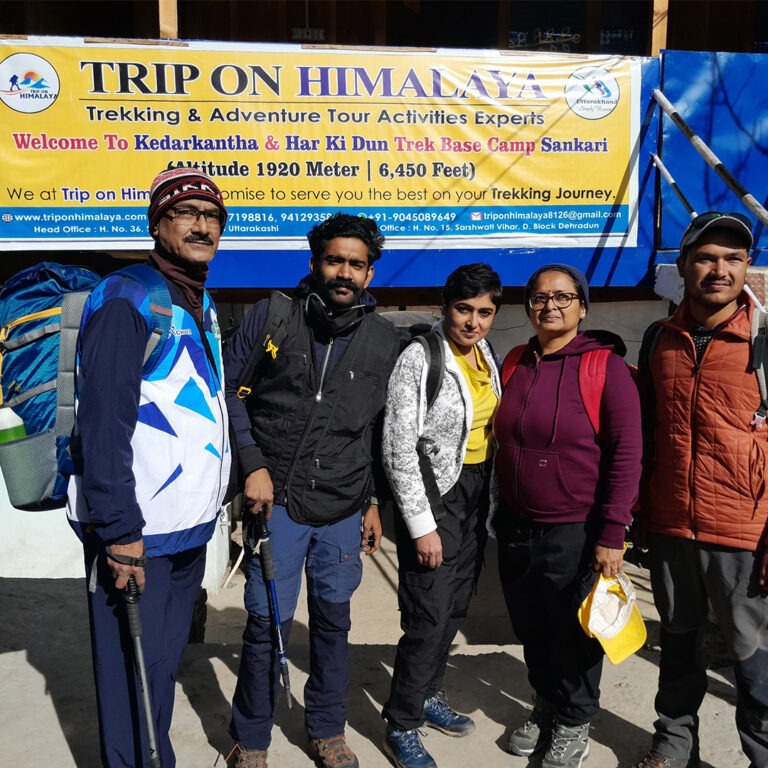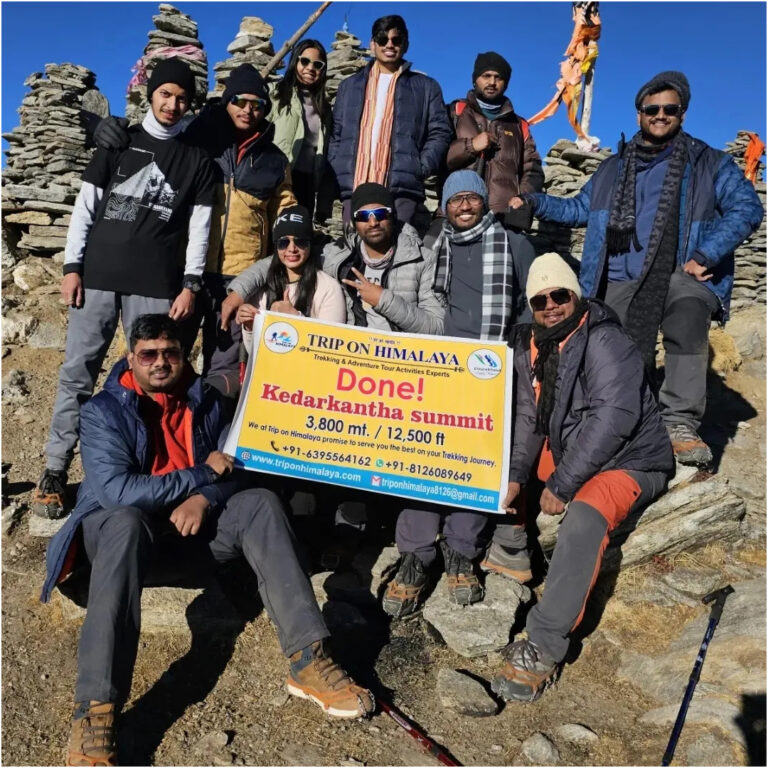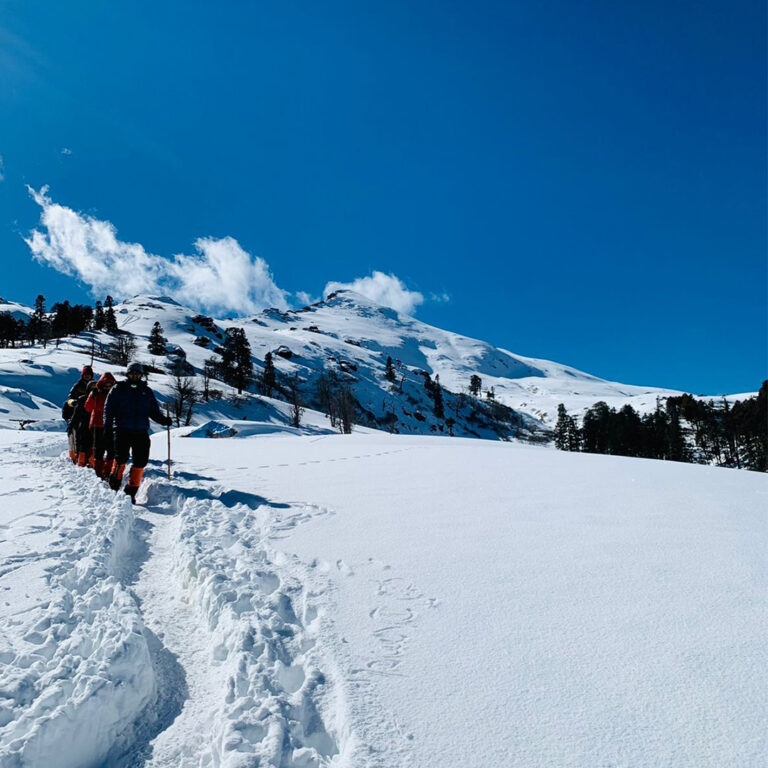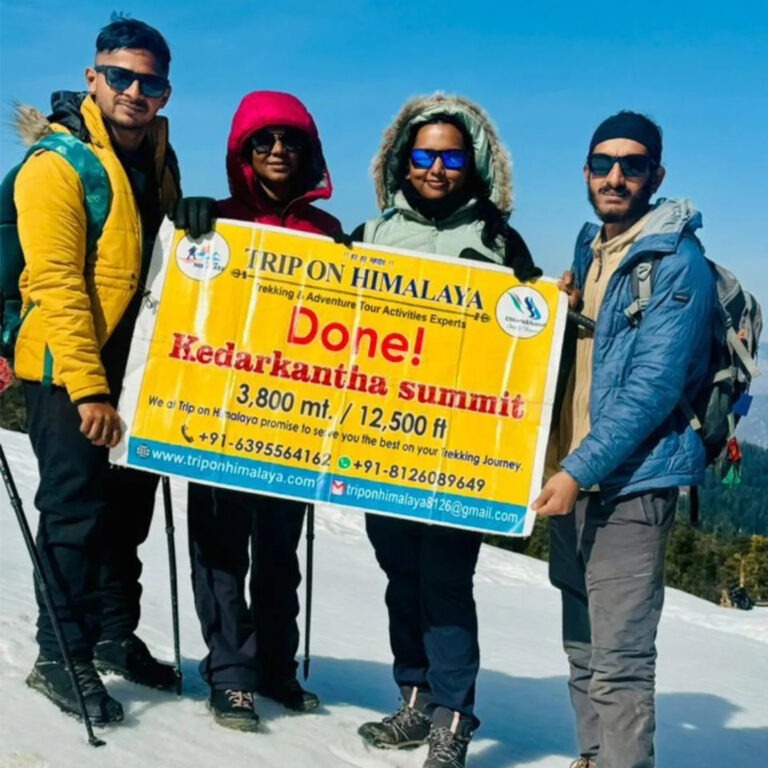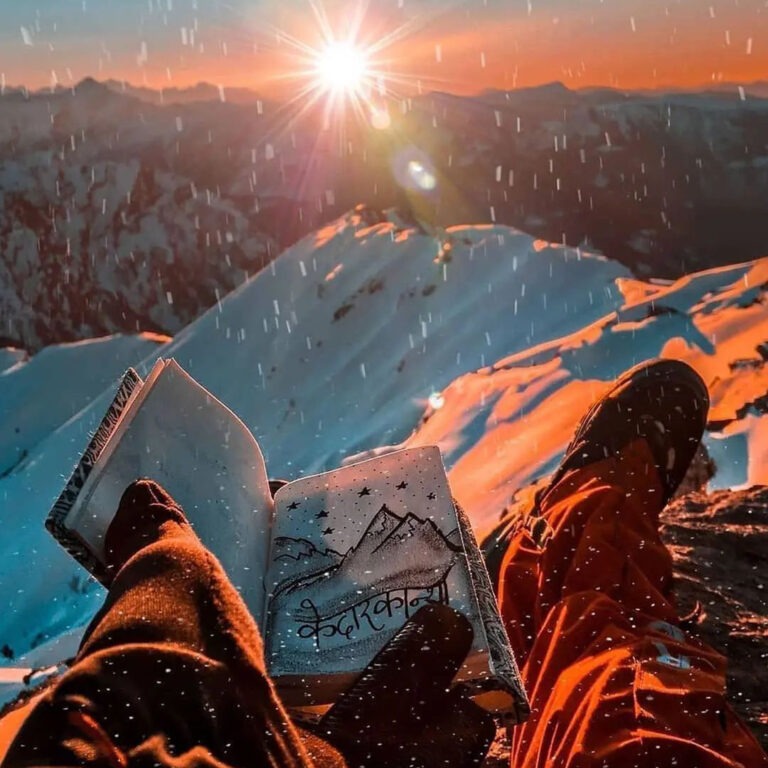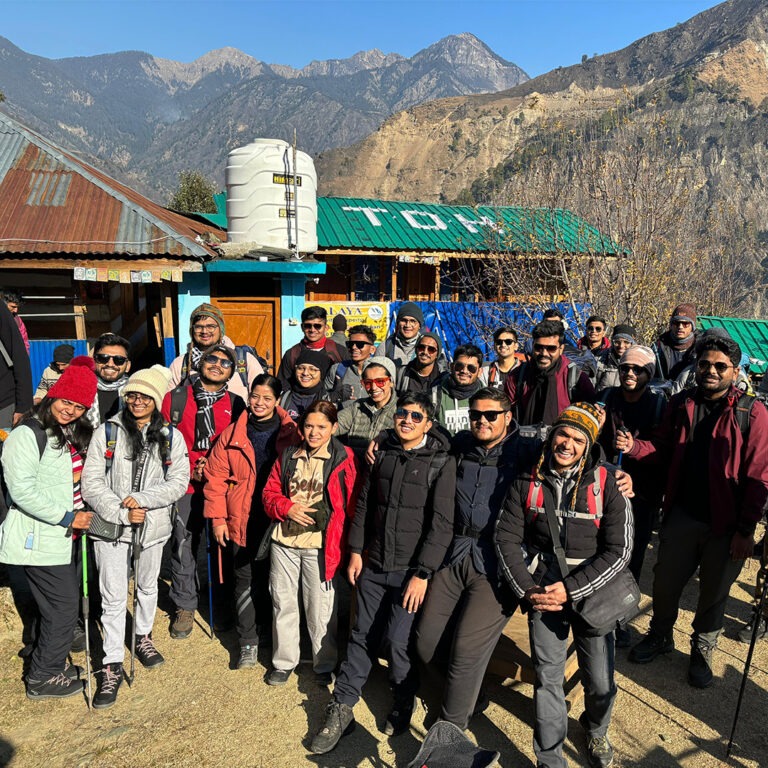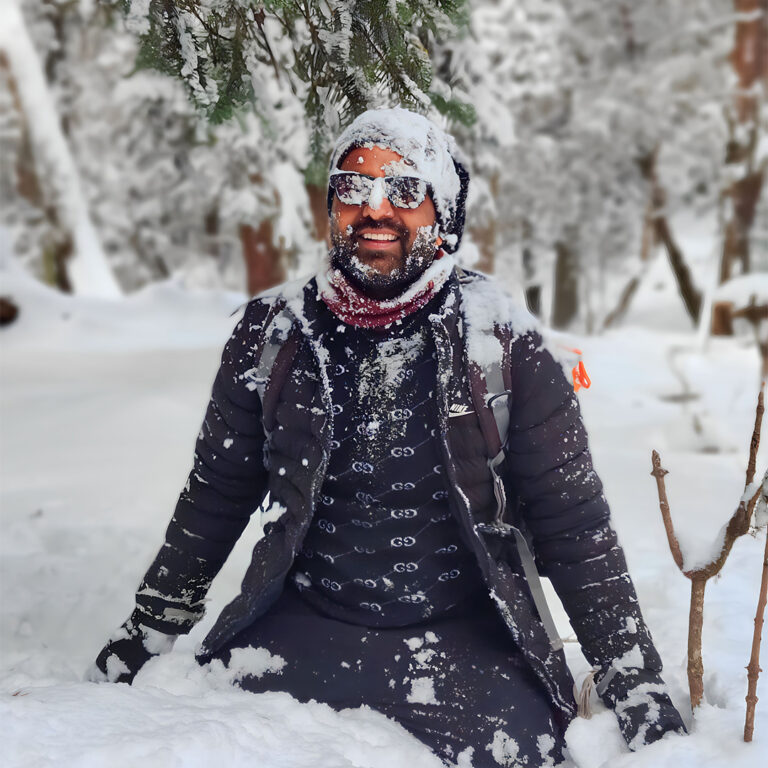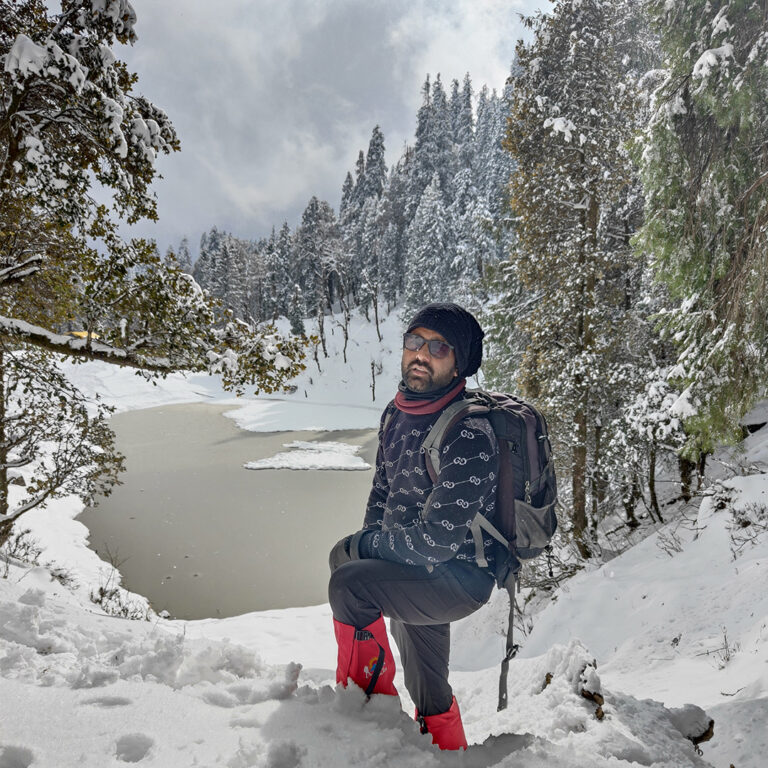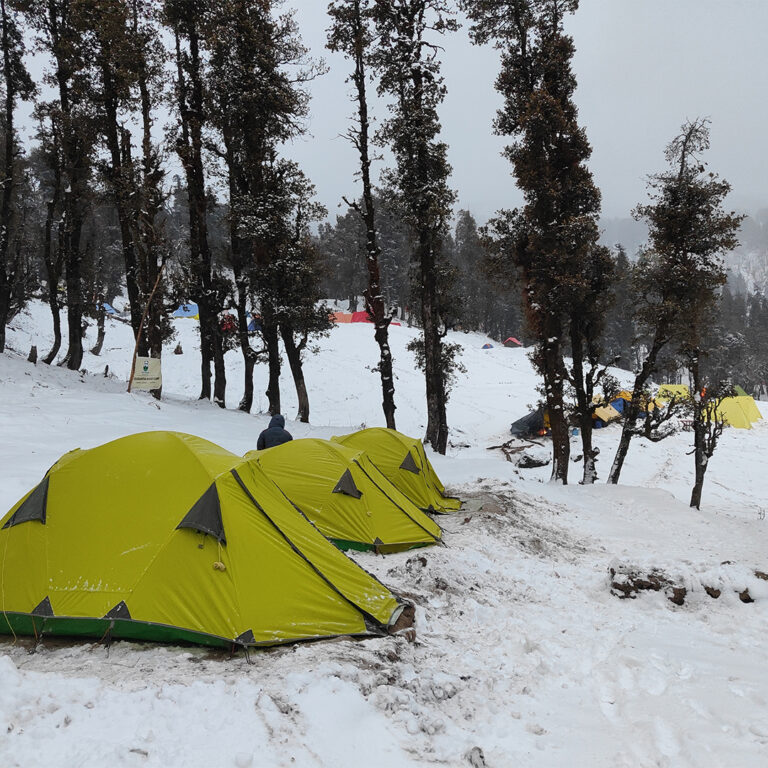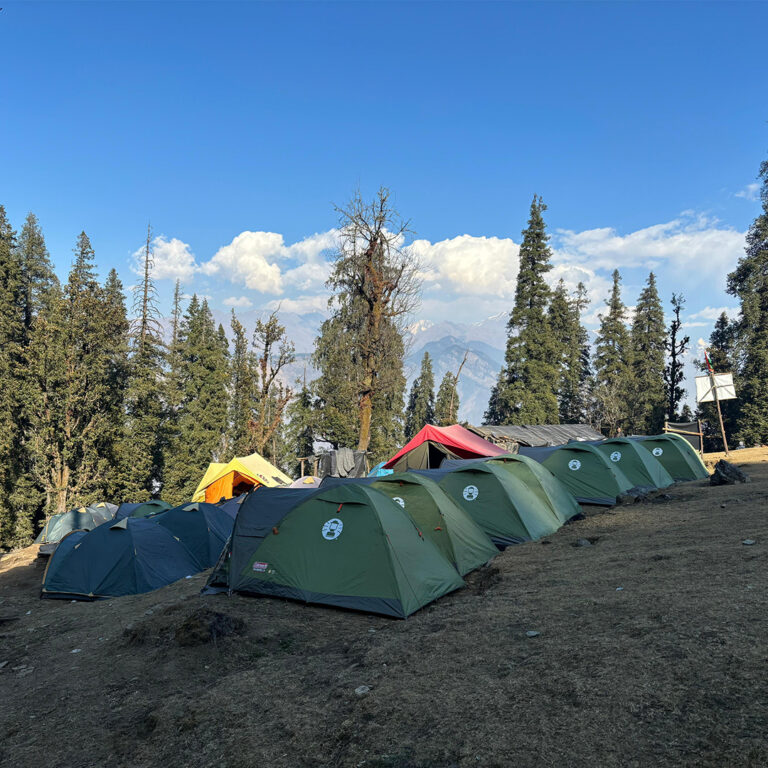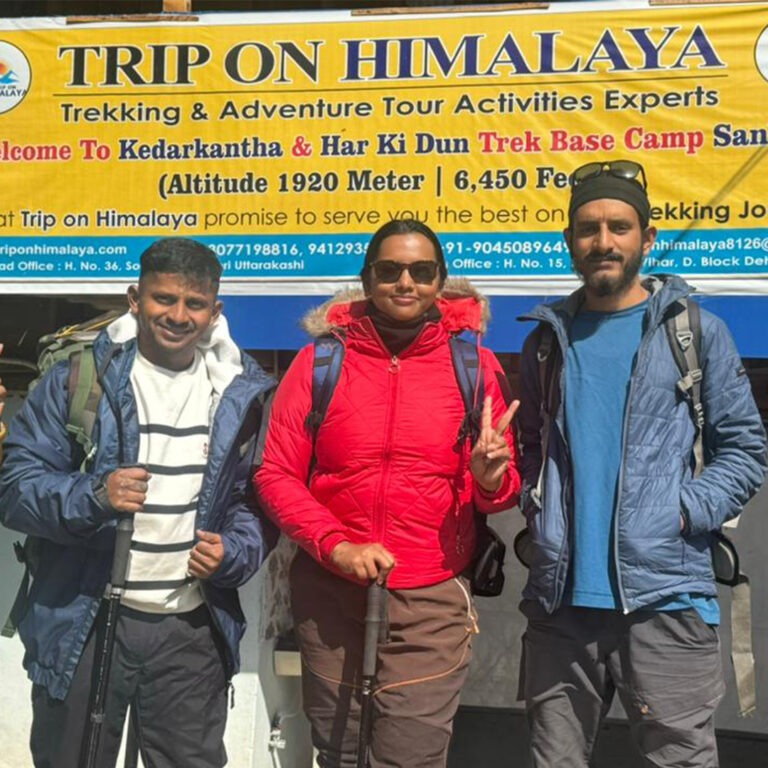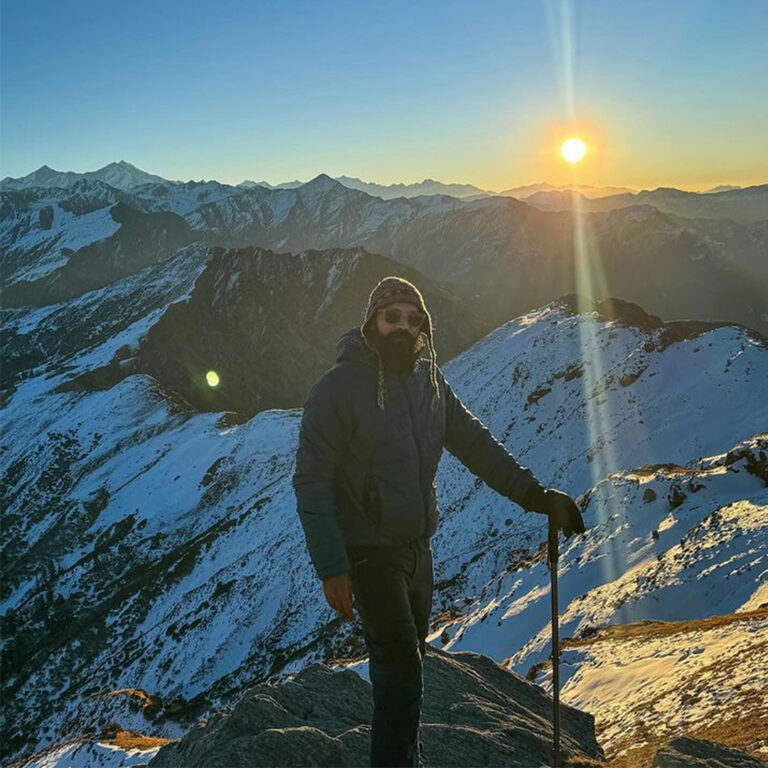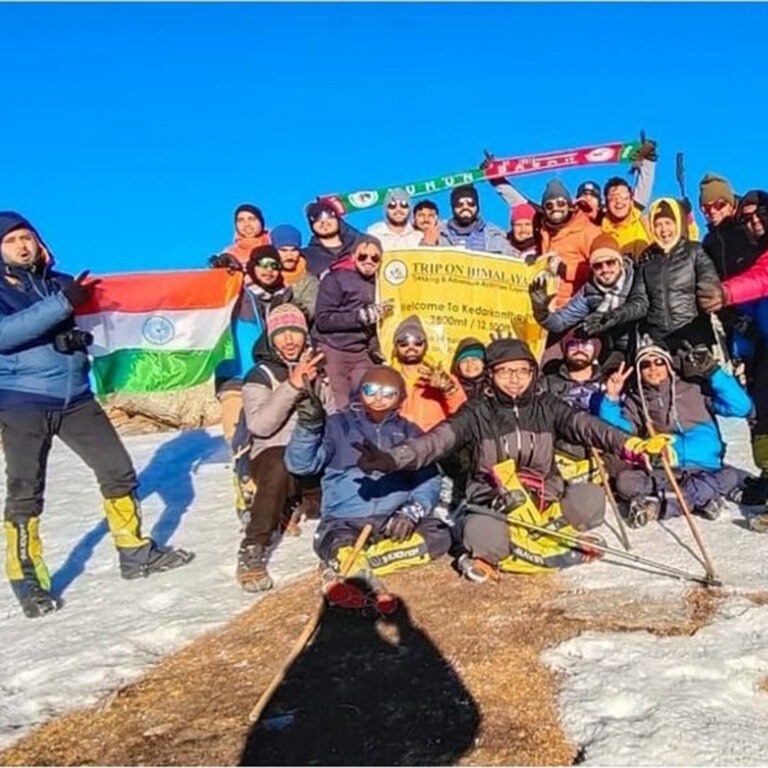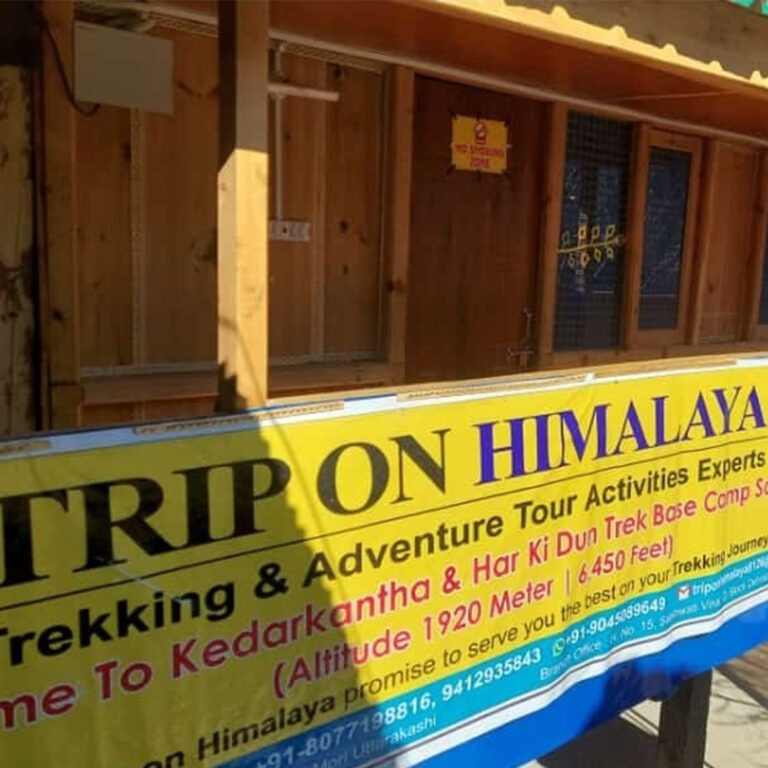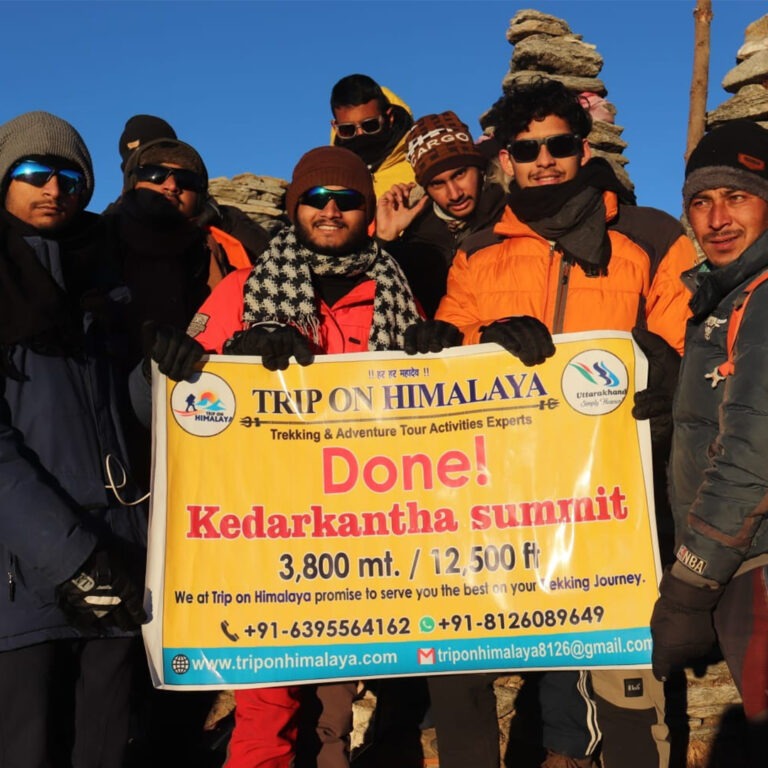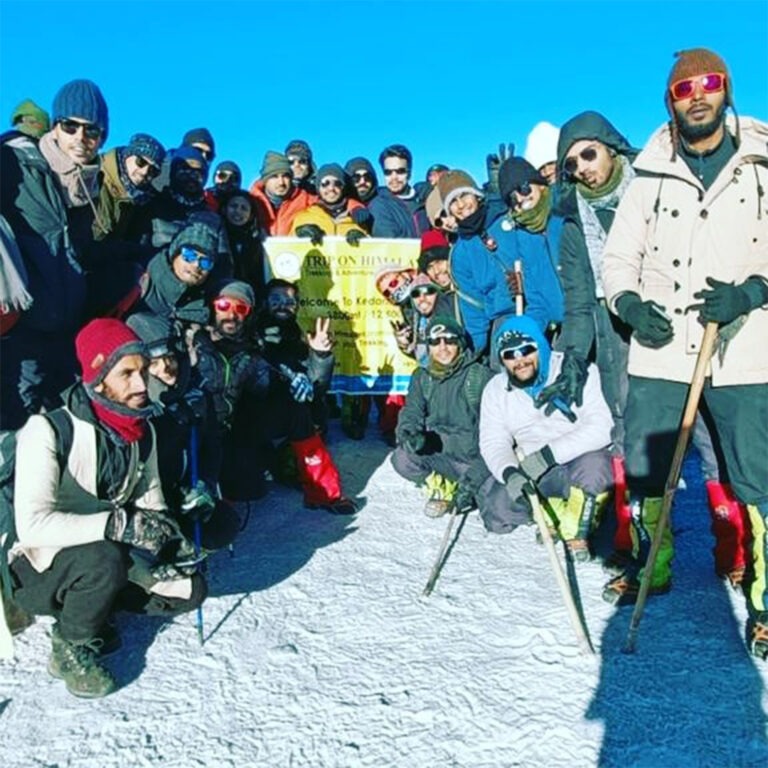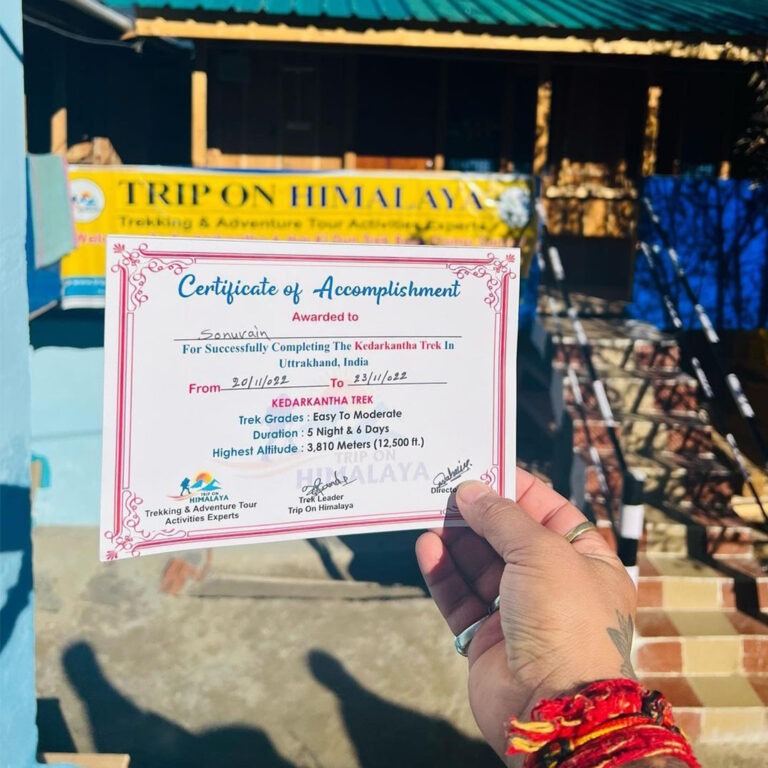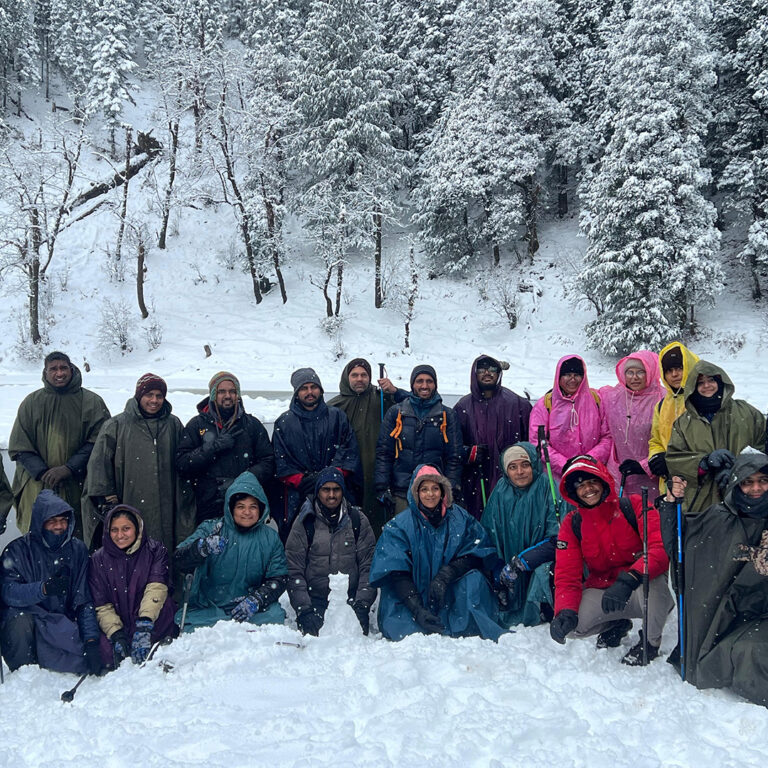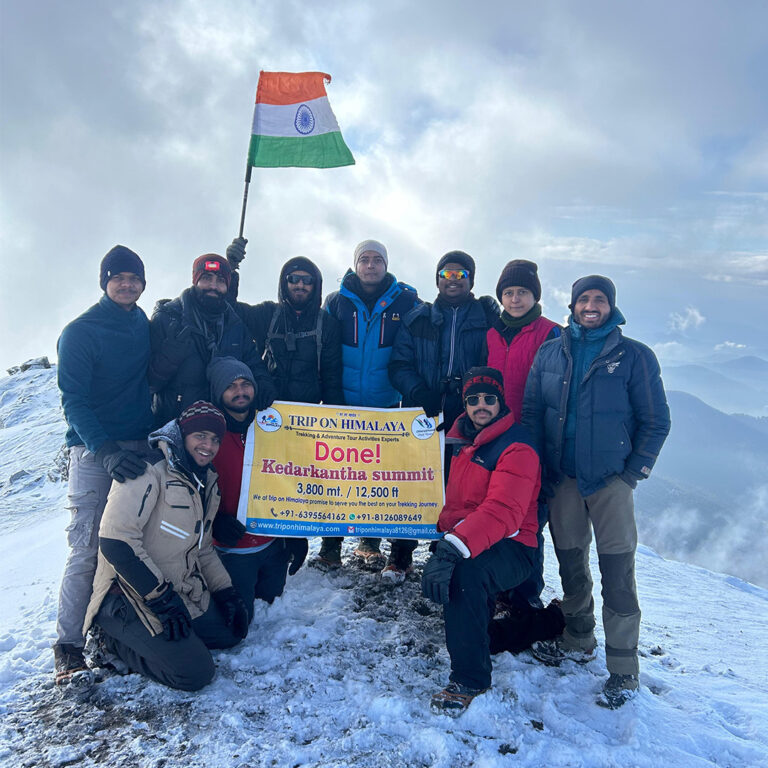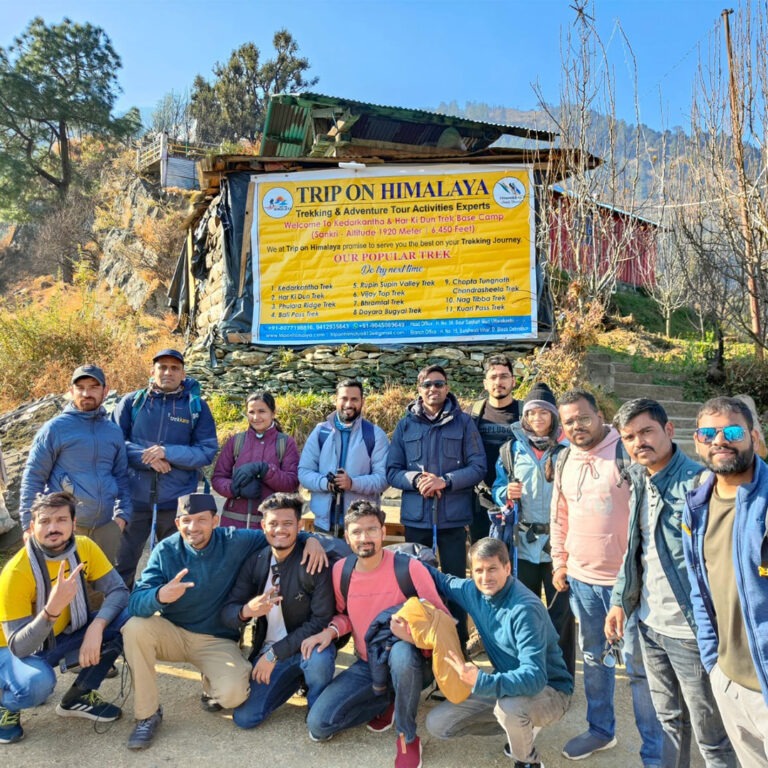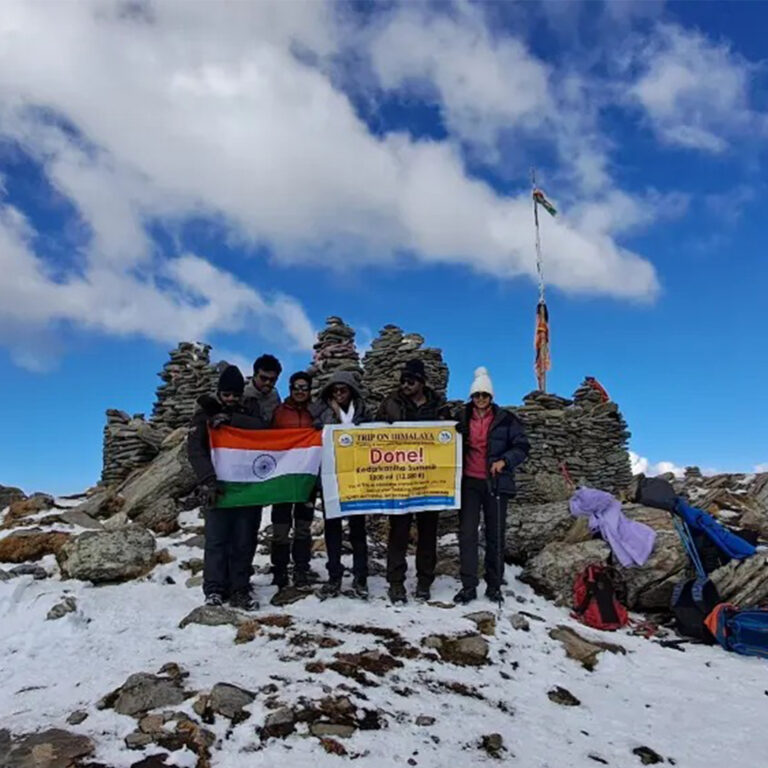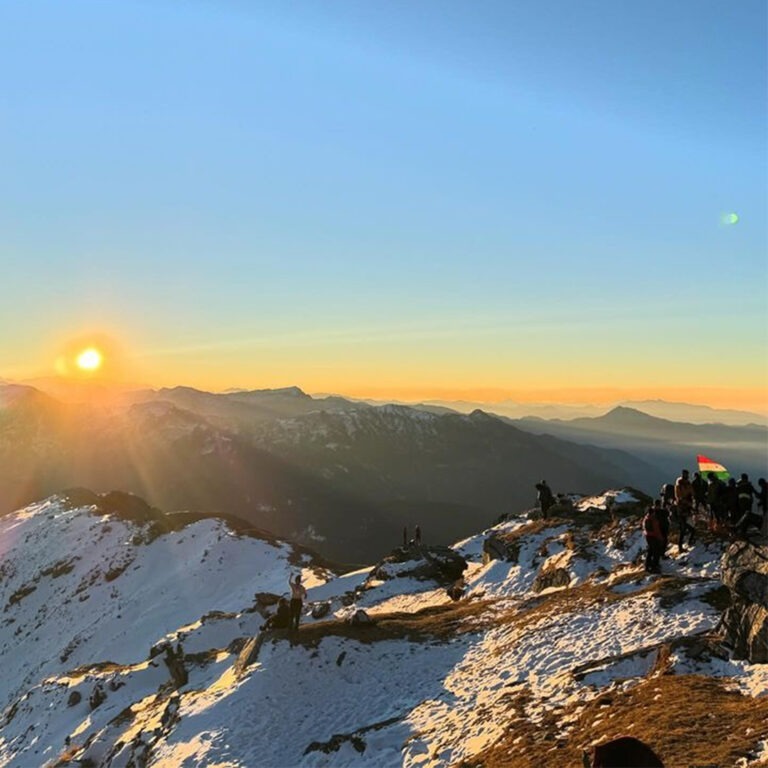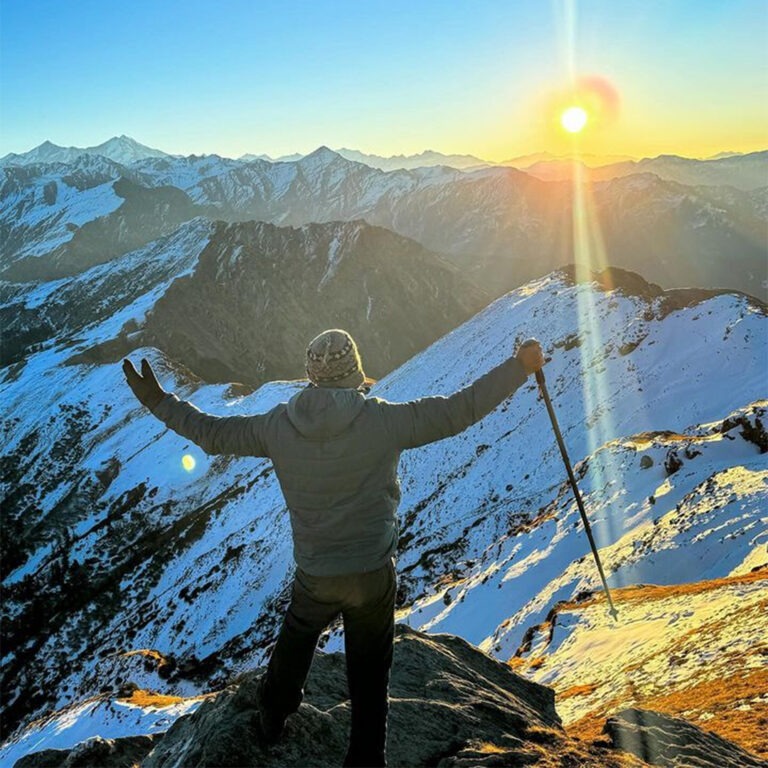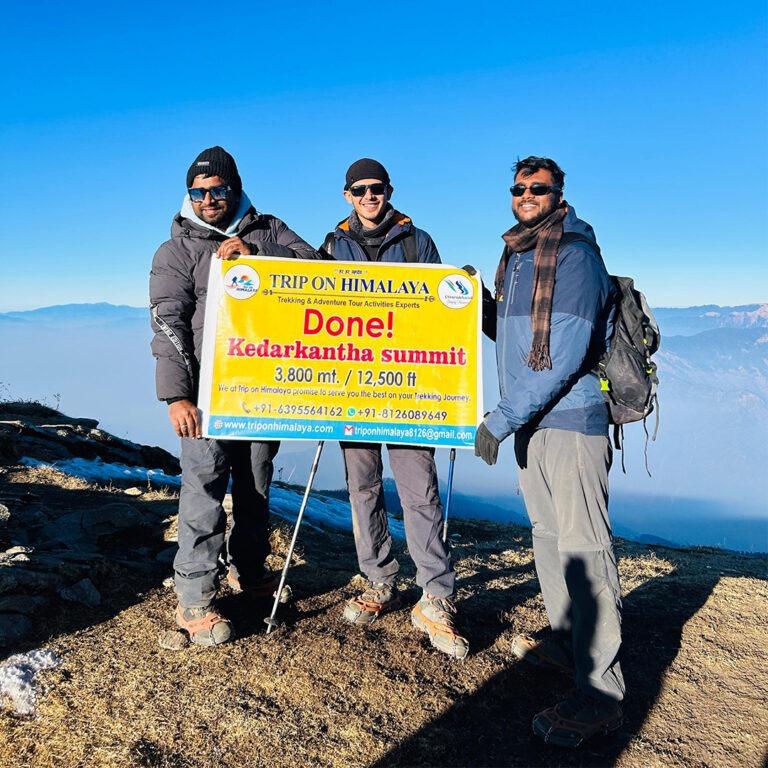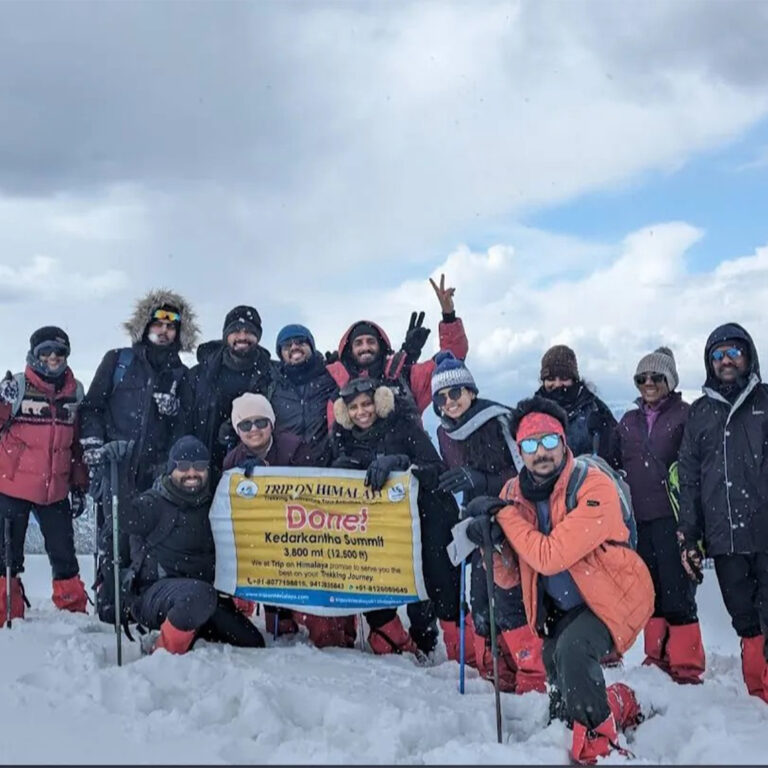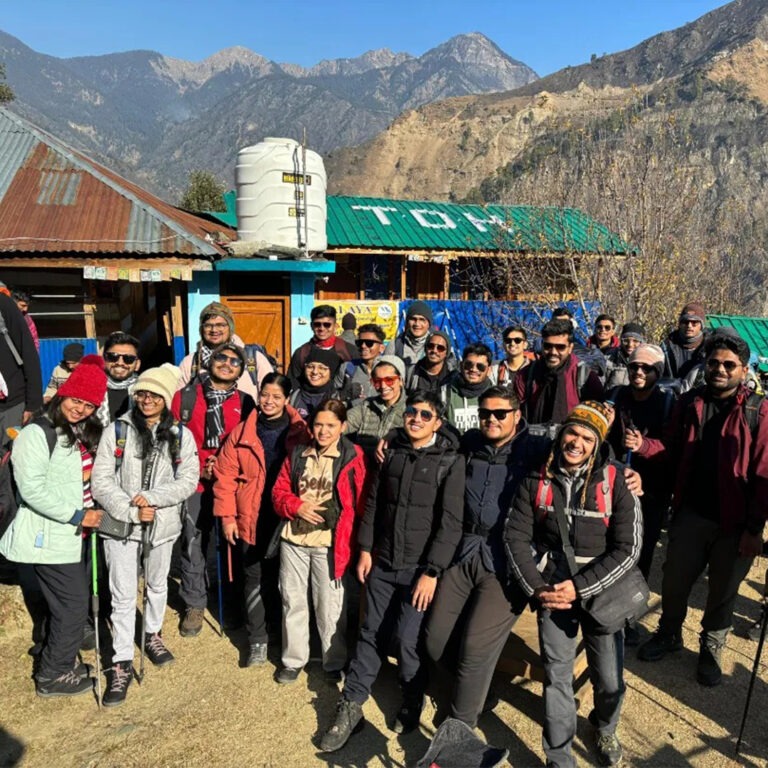Overview
Kedarkantha Trek Queen Of Winter Treks
Called the “queen of winter treks, ” Kedarkantha” is a popular high-altitude winter trek in Uttarakhand, India. Kedarkantha Trek is begins from beautiful Village from sankri. you can Experience local village sankri.
Experience the mesmerizing beauty of Juda Ka Talab, which becomes even more captivating in winter when it freezes over. The lake is also steeped in mythology, adding a mystical charm to your adventure.
From the Kedarkantha summit, you can enjoy stunning 360-degree views of the Himalayan range. Majestic peaks like Swargarohini, Bandarpunch, Black Peak, and Draupadi Ka Danda 2 stand tall in the distance. You’ll also get breathtaking views of Har Ki Dun Valley, Rupin Valley, and the Gangotri and Yamunotri mountain ranges
The Kedarkantha trek offers a mix of scenic terrains with stunning views along the way. It’s easier than many other treks, making it a perfect choice for beginners. After sankri, the Kedarkantha trek enters a no-network zone, giving you a chance to unplug from technology and fully enjoy the peace and beauty of nature.
What Makes This Trek Special
 The Beautiful Road to Base Camp
The Beautiful Road to Base Camp
The journey starts with a spectacular drive Dehradun to Sankri , where lush scenery and breath-taking mountain views can be seen around every corner. The tone for the amazing trek ahead is set by this picturesque journey.
 Sankri Culture
Sankri Culture

You can fully immerse yourself in the local way of life by spending your first and last nights in Sankri. Every element of the rich Himalayan heritage is reflected, from the traditional clothing of the locals to the historical Sankri Banal architecture. It’s a memorable cultural experience that goes beyond a simple visit.
 Dreamy Clearings & Campsites
Dreamy Clearings & Campsites
There are many clearings in Kedarkantha Trek that are ideal for campsites and restrooms. Every clearing has its own distinct charm and breathtaking views. These clearings offer some of the most beautiful sunsets you will ever experience, especially around Bhoja Dhadi. The walk seems balanced and comprehensive because the clearings are positioned at precisely the appropriate intervals
 Choose Your Own Path
Choose Your Own Path
Kedarkantha Trek isn’t just one trail—it’s many. With multiple routes to the summit, you can pick the quieter paths or adjust to changing weather. This flexibility makes the trek both exciting and accessible.
 The Thrill of the Summit Climb
The Thrill of the Summit Climb
The Best part Of Kedarkantha Trek?
The final climb with the peak always in sight, the anticipation builds as you ascend the steep trail. The reward? Jaw-dropping views of the snow-capped Himalayas and a sense of achievement like no other.
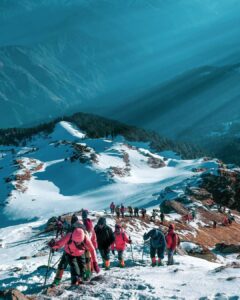
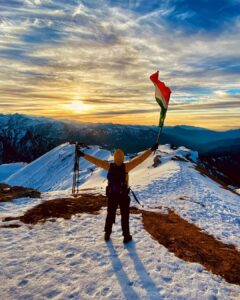
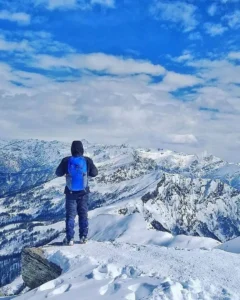
The Kedarkantha Trek isn’t just a trek—it’s a story you’ll live and cherish. Whether it’s the joy of reaching the summit, the magic of forest trails, or the warmth of village life, this adventure is perfect for first-timers and seasoned trekkers alike.
Short Itinerary
Kedarkantha Trek Uttarakhand Itinerary
Day 1 Drive From Dehradun To Sankri Base Village (198 Kilometers, 8 Hours Drive )
- Distance: 200 km | Time: 8-10 hours
- Sankri Altitude: 1,967 meters
- Highlights: pine forests, rivers, and stunning picturesque views.
- The adventure begins with a scenic drive from Dehradun to Sankri, the base village for the Kedarkantha Trek in Uttarakhand. The journey offers views of lush greenery, rivers, and peaceful landscapes, making it an exciting start to the trek.
Day 2 : Trek from Sankri to Juda Ka Taal (4 Kilometers, 4 Hours Trek)
- Distance: 4 km | Time: 4-5 hours
- Juda Ka Talab Altitude: 3,430 meters
- Highlights: Tiny wooden hamlets, picturesque bridges, and rare flora and fauna.
- On Day 2, the trek heads to Juda Ka Talab, a serene lake surrounded by dense forests. The trail passes through picturesque wooden hamlets and charming bridges. Keep an eye out for the region’s unique flora and fauna, adding to the charm of this trek.
Day 3 : Juda Ka Taal To Kedarkantha Base Camp (3 Kilometers, 4 Hours Trek)
- Distance: 3 km | Time: 4 hours
- The day starts with a warm cup of morning tea and a briefing from the trek leader. We begin the trek to Kedarkantha Base Camp, which takes around 3-4 hours. Upon reaching the base camp, we settle into our campsite and enjoy a warm lunch. The rest of the day is for leisure, where we engage in fun activities like snowball fights and other games. Dinner will be served at the campsite, followed by an overnight stay at the base camp.
Day 4 : Trek To Kedarkantha Peak | Back To Juda ka Talab (9 Kilometers, 8 Hours Trek)
- Distance: 9 km | Time: 8 hours
- The most exciting day of the Kedarkantha Trek Uttarakhand starts early at 2:00 AM to catch the sunrise at the peak. We begin the challenging trek to Kedarkantha Summit, which offers stunning panoramic views of the snow-covered peaks of the Himalayas. After soaking in the beauty from the summit, we trek back to the base camp for lunch. We head back to Juda Ka Talab for the final overnight stay at the campsite. A farewell celebration will mark the last night in the mountains.
Day 5: Juda ka Taal To Sankri (4 Kilometers, 4 Hours Trek) | Back To Dehradun (8 Hours Drive)
- Distance: 4 km | Time: 4 hours
- After a hearty breakfast, we begin the descent from Juda Ka Talab to Sankri Village. Upon reaching Sankri, we freshen up and enjoy lunch. Later, we begin the drive back to Dehradun, arriving by late evening. The trek concludes here, and participants head to their respective destinations with unforgettable memories of the Kedarkantha Trek Uttarakhand.
- Note: You will reach Dehradun Railway Station by 10:00 PM.
Details Itinerary
Kedarkantha Trek Itinerary
Day 1 (Pick-up Day): Drive from Dehradun to Sankri
Altitude: 1,950m / 6,400 ft.
Drive Distance: 220 km | 10 hours approximately
Accommodation: Hotel Himalayan Bliss Sankari
Network: Available JIO
Your Journey from Dehradun to Sankri
Your adventure kicks off in Dehradun, where we will pick you up at 7:00 AM. Please arrive at the pickup point on time to ensure a smooth start. From here, we’ll embark on a 220 km scenic drive to Sankri, which takes approximately 10 hours. The journey is as beautiful as the destination—you’ll pass through charming hill towns like Mussoorie, Mori, and Naitwar. The road winds along the Yamuna and Tons Rivers, surrounded by towering pine forests. The last 22 km stretch, as you enter Govind National Park, is the most picturesque, offering glimpses of the park’s exotic flora and fauna. Upon reaching Sankri, we’ll check into our comfortable hotel. After freshening up, you can explore the village of Sankri, known as the trekker’s hub. This village serves as the starting point for many iconic Himalayan treks, including Har Ki Dun and Phulara Ridge. Enjoy a leisurely walk through the village, get to know your fellow trekkers, and soak in the stunning Himalayan sunset. In the evening, enjoy a delicious dinner at the hotel and unwind. You’ll stay overnight in triple, quad, or penta sharing, with separate arrangements for males and females. Get a good night’s rest—we’ll begin our trek the following day!
DAY 2: Sankri To Juda Ka Talab
Distance: 4 km
Duration: 4-5 hours
Altitude Gain: 6,400 ft (1,950 m) to 9,100 ft (2,800 m)
Difficulty: Easy to Moderate
Your trek from Sankri to Juda-ka-Talab is a 4 km scenic journey through dense pine and maple forests, quaint wooden bridges, and wide-open clearings. This section is gentle but steady, making it ideal for beginners while still offering captivating views of the Himalayan range. Route Details:
Route Details:
Departure from Sankri (6,400 ft):
After an early breakfast, we begin our ascent from Sankri Village.
The trail winds through apple orchards, pine forests, and small streams
Midway Point – Forest Clearings:
About 1.5 km into the trek, you’ll reach an open meadow—an ideal place for a short rest and refreshments.
This section offers panoramic views of the Swargarohini peaks.
Final Ascent to Juda-ka-Talab (9,100 ft):
The trail becomes steeper as you climb the last 1 km.
Juda-ka-Talab is a pristine alpine lake, partially frozen in winter. It’s surrounded by dense forests and snow-covered meadows—a perfect spot to unwind.
 Arrival at Juda-ka-Talab Campsite:
Arrival at Juda-ka-Talab Campsite:
DAY 3: Juda Ka Talab To Kedarkantha Base Camp
Distance: 4 km
Duration: 3-4 hours
Altitude Gain: 9,100 ft (2,800 m) to 11,250 ft (3,430 m)
Difficulty: Moderate.
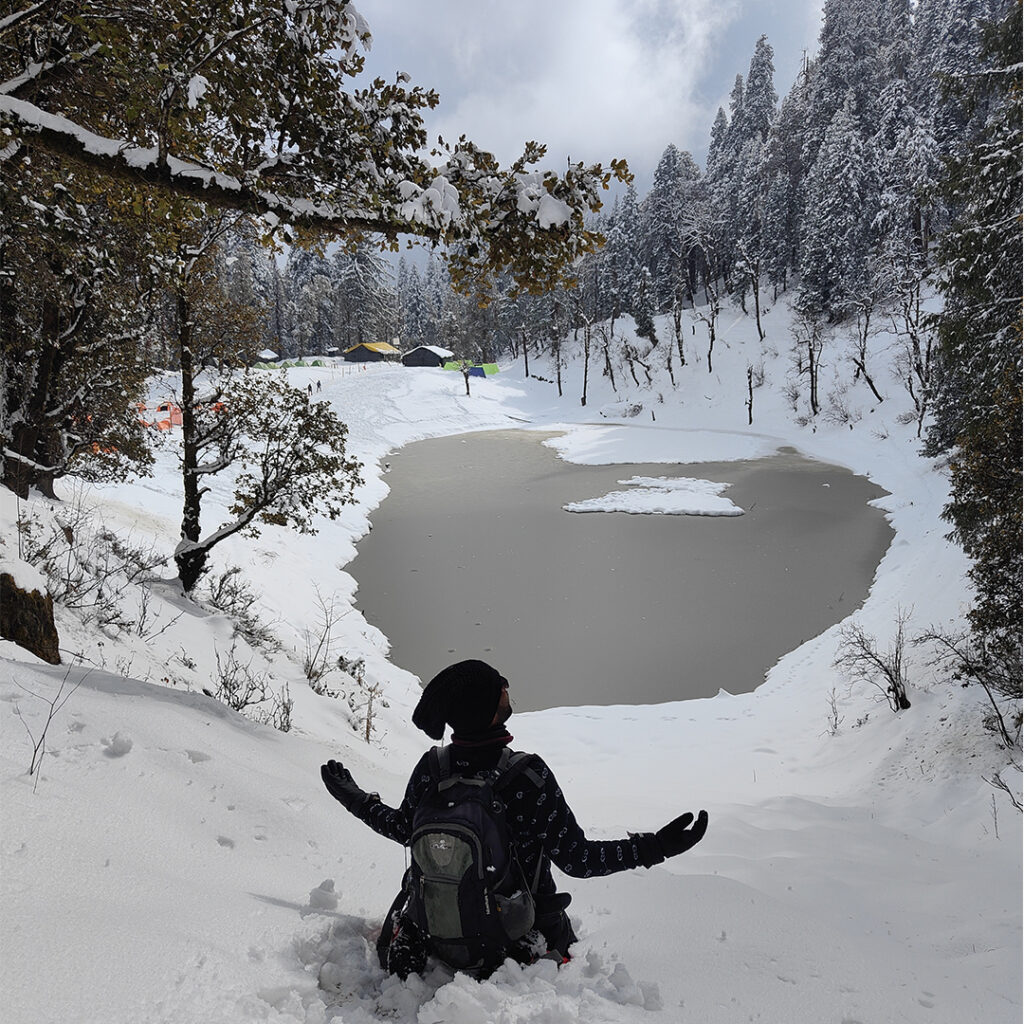
Morning at Juda-ka-Talab Kedarkantha Trek
Start your day early with a warm, hearty breakfast while enjoying a breathtaking sunrise view over the Himalayan peaks. After refreshing yourself, we begin our journey to the Kedarkantha Base Camp.
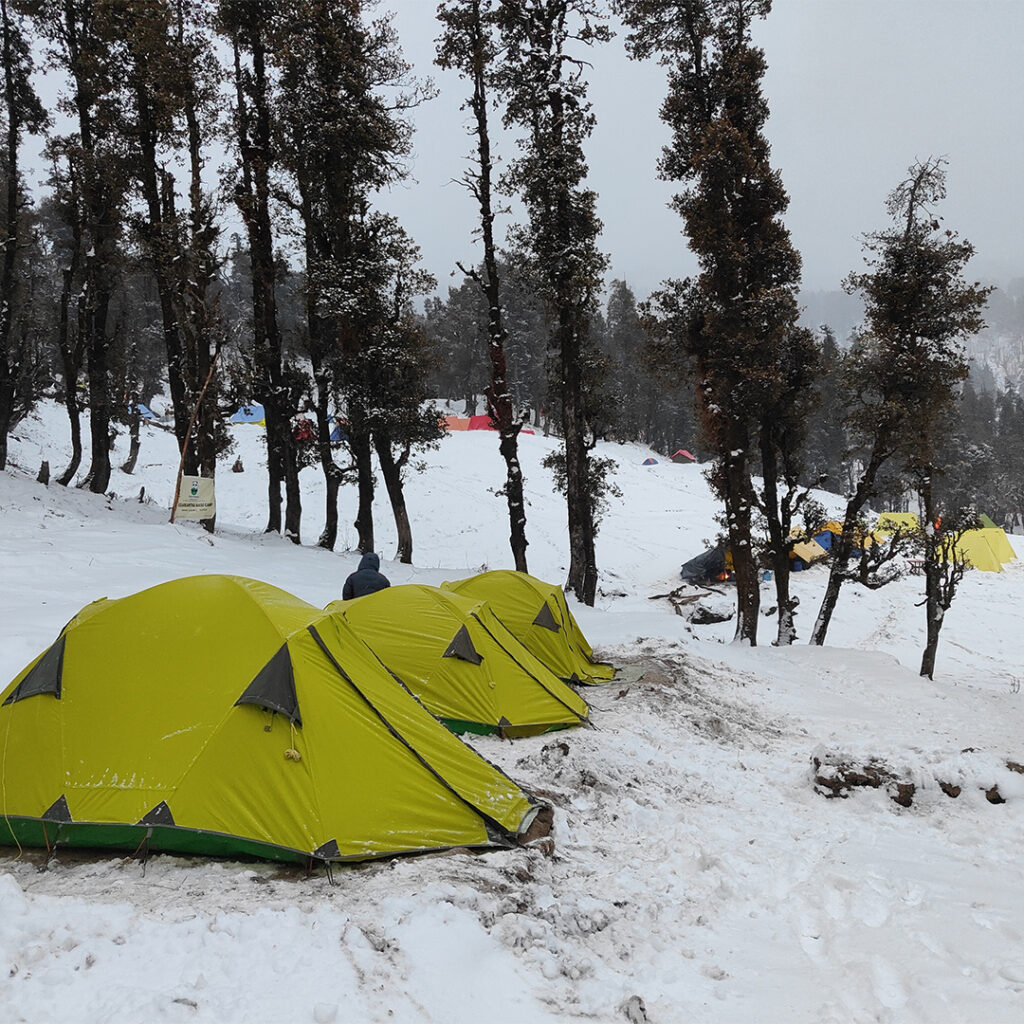
The trail from Juda-ka-Talab to Kedarkantha Base Camp is a gentle ascent, covering approximately 4 km. With a moderate pace, you can comfortably complete this section in 3 hours. The well-marked trail ensures easy navigation, making it ideal for both beginners and experienced trekkers.
Scenic Trail Highlights:
Forest Walk:
- As you ascend, the trail winds through dense cedar, maple, and oak forests.
- In winter, the path is blanketed with snow, offering a magical, white landscape. During summer, the route transforms into lush green meadows.
Open Meadows:
This stretch is perfect for photo breaks and taking in the majestic surroundings. After the forest, the trail opens into vast alpine clearings, revealing panoramic views of the Himalayan valleys.
Day 4 : Kedarkantha Base to Kedarkantha Peak – Descend to Hargaon Camp
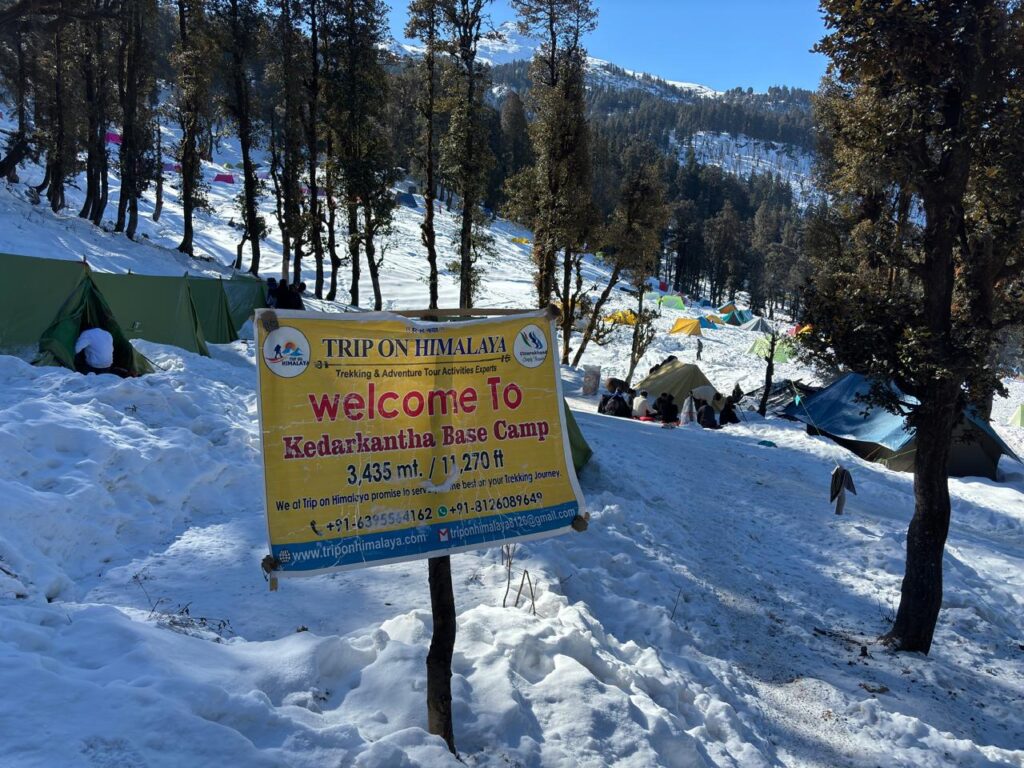
After an exhilarating day at the Kedarkantha summit, we will begin our descent from the base camp to Juda Ka Talab. The trail covers approximately 4 km and takes about 3-4 hours to complete. The descent is easier compared to the climb but requires careful navigation, especially in snowy conditions during the winter months.
We will start the day with a warm breakfast, enjoying the morning views of the Himalayan ranges before heading down. As we descend, the trail takes you through dense forests of oak, pine, and maple. This section of the trek is known for its serene beauty, with snow-covered paths in winter and lush greenery during summer. Along the way, you will pass through open meadows that provide panoramic views of the surrounding valleys. The crisp mountain air and the calm environment make this stretch a refreshing and enjoyable experience.

Upon reaching Juda Ka Talab, you will find yourself in one of the most picturesque campsites of the trek. This pristine alpine lake is partially frozen during winter, creating a magical landscape, while in summer, it is surrounded by verdant meadows. The lake holds mythological significance, as it is believed to have formed when Lord Shiva released water droplets from his hair locks. The tranquil atmosphere of Juda Ka Talab is perfect for relaxing and unwinding after the day’s trek.
After reaching the campsite, you can rest and explore the area. Enjoy a hot lunch, followed by some leisure time to capture photographs, interact with fellow trekkers, or simply soak in the beauty of the surroundings. As night falls, gather around for a warm dinner under a starry sky. The clear night at Juda Ka Talab offers spectacular stargazing opportunities, making this campsite a favorite among trekkers. You will spend the night in comfortable tents, with triple, quad, or penta-sharing accommodations, preparing for the final leg of your trek the following day
Day 5: Kedarkantha Base Camp to Juda Ka Talab – Juda Ka Talab to Sankri – Drive to Dehradun
Your final day on the Kedarkantha trek begins with a refreshing morning at the base camp, where you’ll enjoy a warm breakfast before starting the descent. The journey from Kedarkantha Base Camp to Juda Ka Talab covers approximately 3 km and takes around 2 hours. The trail winds through dense pine and oak forests, offering breathtaking views of the snow-covered landscape during winter or lush greenery in the warmer months. The descent is gentle and easy, allowing you to relax and enjoy the beauty of the surrounding Himalayan wilderness one last time.
Upon reaching Juda Ka Talab, you’ll take a short break to soak in the serenity of this pristine, high-altitude lake. The frozen surface of the lake during winter is a mesmerizing sight, while in summer, the calm waters reflect the towering pine trees around it. After spending some time at Juda Ka Talab, we’ll continue our descent to Sankri, which is another 4 km trek and takes approximately 3 hours. This portion of the trail is easy to navigate, allowing you to reflect on the memorable experiences of the past few days. As we approach Sankri, the familiar village views and terraced fields signal the end of the trek.
Upon arrival in Sankri, we will have a delicious lunch and allow time to freshen up before beginning the drive back to Dehradun. The 220 km drive takes approximately 10 hours, tracing the scenic route through Govind National Park, Naitwar, Mori, and Mussoorie. Throughout the journey, you can revisit the incredible landscapes you experienced during your adventure. We aim to reach Dehradun by 8:00 PM, marking the end of the trek and leaving you with unforgettable memories of the Kedarkantha summit and the breathtaking Himalayan wilderness.
As this is a long travel day, we recommend keeping essentials like water bottles, snacks, and a light jacket accessible for the drive. With the trek’s accomplishment behind you and the Himalayan beauty etched in your memory, you’ll leave with a sense of fulfillment and adventure that will stay with you forever.
How To Reach
How to Reach Kedarkantha Trek ?
Directions to Reach Dehradun
By Air: Jolly Grant Airport is the domestic airport serving Dehradun, with frequent flights from major cities across India.
By Train: The Dehradun Junction is the nearest railway station, offering excellent connectivity to major cities in India.
By Road: Dehradun is well-connected through an extensive road network. You can drive from nearby cities like Delhi or hire a cab/taxi. Additionally, regular bus services operate between Dehradun and other regions.
Route from Dehradun to Sankri:
Take NH 7 from Dehradun to the popular hill station of Mussoorie.
Continue on NH 7 from Mussoorie to Purola, enjoying scenic mountain roads.
Proceed from Purola to Mori and follow signs towards Sankri.
Finally, reach Sankri, which is clearly marked and serves as the trek’s starting point.
Information for Drop-Off
Drop-Off Location: Prince Chowk, Dehradun.
Timing: Arrive at Prince Chowk between 6:30 and 7:30 p.m.
Post-Trek Travel: Plan onward journeys after 9:00 p.m.
Travel Time Estimates:
Tip: Adding a buffer day to your itinerary is highly recommended. If unused, explore local attractions like Dehradun, Mussoorie, or Rishikesh.
TripOnHiamalaya provides comfortable transportation via Bolero, Tempo Traveler, or similar vehicles. For upgrades or further assistance, contact your trek coordinator.
Final Thought: Consistent physical training and mental preparation are the keys to a successful Kedarkantha trek. By adopting a comprehensive fitness plan, you’ll enhance your endurance, reduce injury risks, and fully enjoy the majestic Himalayan landscapes.
Embark on your Kedarkantha adventure with confidence—prepare today for a rewarding and unforgettable trekking experience.
Terms & Condition
Inclusions For Kedarkantha Trek:
1. Accommodation. (Guest house, Home stay, Camping)
2. Meals while on trek (Veg.)
3. Trek equipments: Sleeping bag, mattress, tent (twin sharing), kitchen & dinning tent, toilet tent, utensils and crampon (if required)
4. All necessary permits and entry fees.
5. First aid medical kits, stretcher and oxygen cylinder.
6. Mountaineering qualified & professional trek Leader, guide and Support staff.
7. Transport from Dehradun to Sankri and return (According to itinerary)
8. Mules to carry the central luggage.
Exclusions Kedarkantha Trek:
1. Any kind of personal expenses.
2. Food during the transit.
3. Insurance.
4. Mules or porter to carry personal luggage.
5. Anything not specifically mentioned under the head.
6. Any kind of emergency evacuation charges.
Note Kedarkantha Trek:
Normally Trip on Himalaya expect to carry your personal luggage on your own, if you wish to offload your backpack, you can give it to Mule.
Charges of offloading backpack:-
INR 1200/- if you make an online payment, 10 days in advance
INR 1500/- if you inform us after reaching Sankri
The backpack cannot weigh more than 11 kgs. Backpack should have waterproof cover. Suitcases/strolleys/ bags will not be allowed.
To book Kedarkantha Trek/ adventure program please use our online booking form or, alternatively, you can call us on the given for confirmation of tour you have to wire a deposit and initial deposit.
Paying the Trek/ Adventure activity fee Kedarkantha Trek:
The fee can be paid by online transfer/check deposit/ demand draft. Instruction for payment will be forwarded along with your confirmation email. When your transfer is done, please e-mail us a confirmation mail with your transfer details, so that we can follow up your reservation efficiently.
When to Book Kedarkantha Trek:
It is wise to make your booking at least two months in advance. However, if you want a good deal on your domestic/international flight, we recommend organising your trip at least five months in advance. (Please contact us if you require a late booking).
Terms for Cancellation & Refund Kedarkantha Trek:
Customer is suppose to make a full payment in advance for the confirm bookings.
If in case a confirmed booking needs to be cancel than below are the refund policies
1. Prior 30 days of the confirmed date, 50% of the total amount would be refunded
2. Prior 25 days of the confirmed date, 40% of the total amount would be refunded
3. Prior 20 days of the confirmed date, 30% of the total amount would be refunded
4. Prior 15 days of the confirmed date, 20% of the total amount would be refunded
5. Prior 10 days of the confirmed date, 10% of the total amount would be refunded
Note: After the said time the Trip on Himalaya would not be entertaining any cancelation and no amount would be refunded whatsoever.
Trek Essentials
Trekking Gear Kedarkantha Trek
1. Ruck sack bag with rain cover. Qty -1
2. Day Pack Bag – Recommended for treks with summit day
3. Head Torch with spare Batteries. Qty -1
4. U V protection sunglasses. Qty -1
5. Water Bottles: 2 bottles of 1 liter each
Footwear Kedarkantha Trek
1. Non-skid, deep treaded, high-ankle trekking shoes Qty -1
2. Pair of light weight Slipper/Sandals Qty -1
Clothing Kedarkantha Trek
1. Quick Dry Warm lower or Track Pants. Qty – 2
2. Full sleeves T-shirts/ Sweatshirts. 1 for every 2 days of trekking
3. Pair of thick woolen socks. 1 pair for every two days of trekking
4. Thermal Body warmer Upper & Lower. Qty-1
5. Undergarments. Qty – 1 for every day of trekking
6. Warm jacket closed at wrist & neck .Qty-1
7. Full sleeves sweater. Qty -1
8. Rain wear ( Jacket & Pants ) . Qty-1
9. Pair of waterproof, warm gloves. Qty-1
10. Woolen cap. Qty-1
11. Sun shielding Hat. Qty -1
Toiletries Kedarkantha Trek
1. Personal toiletries kit (Small Towel, Toilet paper, paper soap, Bar soap, toothbrush, toothpaste, cold cream etc.)
2. Sun screen lotion small pack . Qty -1
3. Lip Balm small pack. Qty-1
Utensils Kedarkantha Trek
1. Small size, Light weight & Leak proof lunch box. Qty-1
2. Plate. Qty- 1
3. Spoon.Qty-1
4. Tea/Coffee (plastic) Mug.Qty-1
Miscellaneous Kedarkantha Trek
1. Camera (Optional)
2. Carry your medicines in plenty in case you have any specific ailment. Consult your doctor before joining the trek.
3. Dry fruits, Nuts, Chocolate bars (Optional)
FAQ's
Kedarkantha Trek FAQ’s and Information
1. Where is Kedarkantha Trek?
Kedarkantha Peak is based in the Garhwal region of Uttarakhand. From Dehradun, it is approximately 215 kilometers away.
2. How to reach Kedarkantha Trek?
By Air:
Jolly Grant Airport, Dehradun, is located about 20 km from the city. You will find a daily flight from Delhi to Dehradun.
By Train:
Overnight train to Dehradun from Delhi
By Bus:-
From Delhi’s ISBT Kashmere Gate, regular bus service from Delhi to Dehradun is available.
3. Is the Kedarkantha Trek safe for female travelers?
Yes! Kedarkantha Trek is safe for female Travellers.
4. What is the age limit for the Kedarkantha Trek?
5. Are there any extra charges other than the Kedarkantha Trek Package cost?
There are no hidden charges, but we will charge you an extra fee if you choose activities not included in the Kedarkantha Trek Package.
6. How can you reach Sankri from Dehradun?
You can get direct buses from Dehradun to Sankri. Remember, you don’t need to pre-book these buses.
7. What is the minimum cost for the Kedarkantha Trek?
8. What is the best time to visit Kedarkantha?
The best time to visit Kedarkantha is winter, i.e., November to March.
9. What is the minimum size of the Kedarkantha Fixed Departure Group?
The minimum size of the Kedarkantha Fixed Departure Group is eight people.
10. Which city is near Kedarkantha?
About 200 kilometers away, Dehradun is the closest city to Kedarkantha. Dehradun is the main stop for travelers en route to the trek’s base camp in Sankri.
11. Where is Kedarkantha ranked in India?
Kedarkantha is considered one of the top winter treks in India, especially for beginners and snow enthusiasts. Its ranking often depends on criteria like popularity, accessibility, and scenic beauty.
12. How risky is Kedarkantha?
Kedarkantha is a moderate trek that is relatively safe for beginners. However, risks such as altitude sickness, slippery trails, or extreme weather conditions can arise. Proper preparation and guidance from experienced trek leaders minimize these risks.
13. What is the cost of the Kedarkantha trek?
The average cost of the Kedarkantha trek ranges between ₹5,000 and ₹7,000 per person, depending on the food, equipment, and accommodation.
14. How far is the Kedarkantha trek from Delhi?
The distance between Delhi and Sankri, the base camp of Kedarkantha, is approximately 430 km. The journey typically takes around 10–12 hours by road.
15. Is the Kedarkantha Trek difficult?
No, Kedarkantha is a moderate-level trek. It’s ideal for beginners with a basic level of fitness. The ascent to the summit can be challenging due to snow and steep sections, but it’s manageable with proper preparation.
16. Is the Kedarkantha trek safe now?
Yes, the Kedarkantha trek is considered safe for trekking. However, always check weather updates and follow safety guidelines provided by trek leaders.
17. Is Kedarkantha the same as Kedarnath?
No, Kedarkantha and Kedarnath are entirely different.
- Kedarkantha: A trekking peak in Uttarakhand known for its scenic beauty.
- Kedarnath: A holy pilgrimage site dedicated to Lord Shiva, famous for the Kedarnath Temple.
Fitness
Fitness For Kedarkantha Trek
Tips to get fit for Trekking
Experiencing trek is almost everyone’s passion or dream. But before starting or planning for a hike, you must be aware of the during and post-trek pain of your body. It is essential to be strong enough to enjoy your whole trek without any disruption of body ache. One book or decide several months before going on a hike, so you have a significant amount of time exercising your body and training it to become flexible for the trek.
Following are some advantages of training yourself before trek:
- It fosters aerobic fitness.
- It improves blood circulation and breathing functions as well.
- It makes the heart strong, preventing it from any problem.
- Muscles get build-up which is very beneficial.
Therefore, one must do practice to gain all these benefits. It is not only for the trek but for lifetime fitness also.
Let’s have a look at some factors which must be kept in mind to practice before trek:
Importance of Stretching
It helps the body become flexible and allows you to move your body in any direction you want quickly. It helps make the joints such as shoulders, elbows, hips and knees stronger to prevent any mishappening. It provides much relaxation to your body and relieves the pain. And if you are going on a trek, it is essential to practice stretching way before your hike. It will help you in moving to the higher altitudes region more efficiently.
Sleep like baby
It is always said that one must sleep like a baby. It means sleep without any worries. This makes you have an adequate amount of sleep which is a significant factor in daily life. So, practice it daily and also before your trek. Try to make yourself comfortable to sleep at higher altitudes.
Good Shoes-Good Trek
It is so evident that one has to walk and only walk while Trekking, so it is far more essential to have a good pair of trekking/hiking shoes. Practice walking by wearing your boots before the trek to make yourself used to them. You may opt for an option to keep an extra pair in your bag while trek to help yourself in the opposite condition.
Why Is Fitness Key for the Kedarkantha Trek?
The Kedarkantha trek, reaching altitudes of up to 12,500 feet, is a thrilling yet demanding adventure. This high-altitude journey involves steep ascents and descents, where reduced oxygen levels and cold temperatures can challenge even seasoned trekkers. Maintaining a strong fitness level is essential for adapting to these conditions and preventing fatigue or altitude-related issues.
Key Physical Fitness Requirements
The trek involves 4-6 hours of continuous walking daily on rugged terrain. Building cardiovascular endurance and overall stamina is crucial for sustaining energy throughout the journey. Incorporate the following exercises into your routine:
Running or Jogging: 5-7 km at a moderate pace, 4-5 times a week to enhance cardiovascular health.
Cycling: Boosts lung capacity and strengthens leg muscles.
Swimming: Improves breathing efficiency and overall endurance.
Stair Climbing: Prepares your legs for steep inclines and declines.
Tip: Consistently engage in these activities for at least a month before the trek to improve your physical readiness.
Strength and Muscle Endurance – Powering Your Steps
Carrying a backpack on snowy, uneven trails requires robust muscle strength and endurance. Focus on these targeted exercises:
Leg Strength: Perform squats, lunges, and step-ups (3 sets of 15 reps each) to enhance lower body power.
Core Stability: Practice planks, crunches, and leg raises for improved posture and endurance.
Upper Body Strength: Include push-ups, shoulder presses, and light weightlifting to manage your backpack comfortably.
Balance Training: Engage in one-leg stands and stability exercises to navigate uneven surfaces with ease.
Flexibility and Mobility – Preventing Injuries
Flexible muscles reduce stiffness and lower the risk of injury, especially in cold weather. Incorporate the following stretches:
Hamstring and Calf Stretches: Prevent cramps and improve overall mobility.
Hip Openers: Facilitate long-duration walking and climbing.
Yoga and Dynamic Stretches: Enhance flexibility while promoting mental relaxation.
Tip: Dedicate 10-15 minutes daily to stretching or yoga for optimal muscle agility and injury prevention.
Mental Preparation – Overcoming Challenges
Beyond physical fitness, mental resilience is vital for enduring the trek’s harsh conditions and long hours. Strengthen your mindset by:
Visualization: Imagine the trek experience and set small, achievable fitness goals.
Breathing Exercises: Practice Pranayama to improve lung capacity and calm your mind.
Positive Mindset: Gradually increase physical effort and embrace a can-do attitude.
Altitude Acclimatization – Adapting to High Elevations
Ascending rapidly to high altitudes can lead to mild altitude sickness if not managed carefully. Prepare in advance by:
Staying Hydrated: Drink 3-4 liters of water daily to support acclimatization.
Avoiding Alcohol and Smoking: These habits reduce oxygen intake and impair stamina.
Gradual Ascent Training: Practice hiking at elevations above 8,000 feet if possible to simulate high-altitude conditions.
Final Thought: Consistent physical training and mental preparation are the keys to a successful Kedarkantha trek. By adopting a comprehensive fitness plan, you’ll enhance your endurance, reduce injury risks, and fully enjoy the majestic Himalayan landscapes.
Embark on your Kedarkantha adventure with confidence—prepare today for a rewarding and unforgettable trekking experience.
Map
Gallery
Safety
Safety Points to Remember for the Kedarkantha Trek
Ensuring your safety during the Kedarkantha trek is paramount. Follow these key guidelines:
Physical Readiness: Arrive at the starting point in the best possible physical condition to handle the trek’s challenges.
Stay Focused: Keep both your feet and mind calm to make the journey easier and more enjoyable.
Trail Awareness: Always stay on the marked trails and follow your guide’s instructions to avoid getting lost.
Group Safety: Stick with your group and avoid trekking alone, especially in low-visibility conditions.
Weather Preparedness: Be aware of weather forecasts and carry suitable clothing to handle extreme cold, snow, or sudden changes.
Medical Check-Up: Consult your physician if you have any pre-existing health conditions before embarking on the trek.
Carry Medical Equipment: Always have essential medical supplies, including personal medications and first aid kits.
Emergency Preparedness: Trip on Himalaya ensures trekkers have access to a fully stocked first aid kit, including oxygen cylinders and essential medications.
Rescue Support: In case of serious difficulties, stretchers are available to transport trekkers back to the base camp.
Oxygen Availability: Our camps are strategically located near the tree line, ensuring sufficient oxygen levels for trekkers.
Altitude Awareness: Recognize signs of altitude sickness (headache, nausea, dizziness) and inform your guide immediately if symptoms occur.
Hydration: Drink plenty of water to stay hydrated and combat altitude sickness. Avoid caffeinated or alcoholic beverages.
Night Safety: Use headlamps or flashlights after dark, and be cautious of slippery or uneven surfaces.
Respect Nature: Avoid disturbing wildlife and follow Leave No Trace principles to preserve the environment.
Communication: Carry a fully charged phone and, if possible, a power bank. Communication devices provided by Trip on Himalaya ensure reliable contact in emergencies.
Final Thought: Consistent physical training and mental preparation are the keys to a successful Kedarkantha trek. By adopting a comprehensive fitness plan, you’ll enhance your endurance, reduce injury risks, and fully enjoy the majestic Himalayan landscapes.
Note
Backpack Offloading Charges with TripOnhimalaya
At TripOnHiamlaya, you are expected to carry your own personal gear during the trek. However, if you wish to lighten your load, you can hand over your backpack to a mule for offloading. Here are the charges and details:
 Offloading Charges:
Offloading Charges:
- ₹1300 INR: If paid online at least 10 days before the trek.
- ₹1500 INR: If you decide to offload your backpack after reaching Sankri.
- Only backpacks are allowed for offloading. Luggage bags and stroller bags are not permitted.
- Your backpack must have a waterproof cover for protection.
 Special Offer – Unlimited Treks!
Special Offer – Unlimited Treks!
- One-time Payment: Pay for a trek once, and you can repeat the same trek unlimited times without paying the trek fee again!
- If you cannot finish a trek or want to repeat it after completion, you can rejoin the same trek as many times as you want, free of cost.
 Important Notes:
Important Notes:

 The Beautiful Road to Base Camp
The Beautiful Road to Base Camp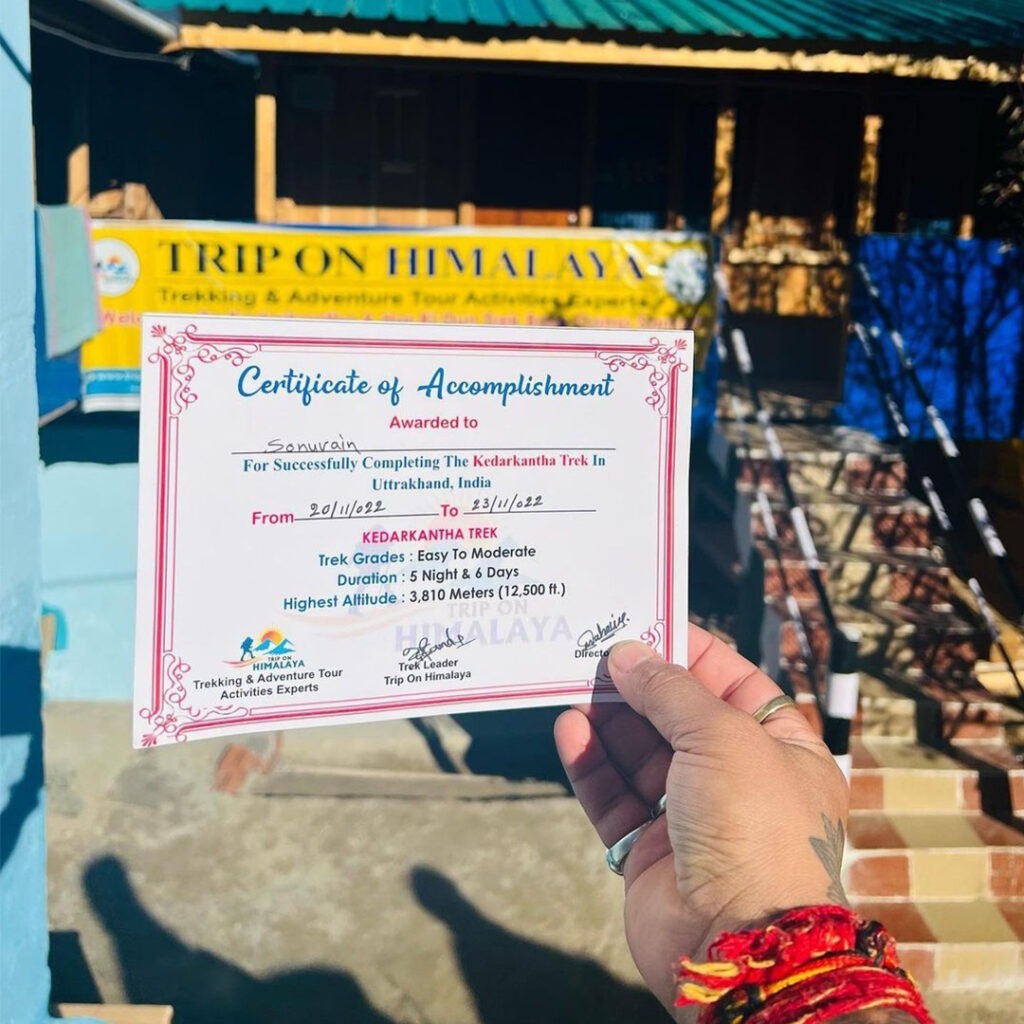
 Sankri Culture
Sankri Culture
 Dreamy Clearings & Campsites
Dreamy Clearings & Campsites 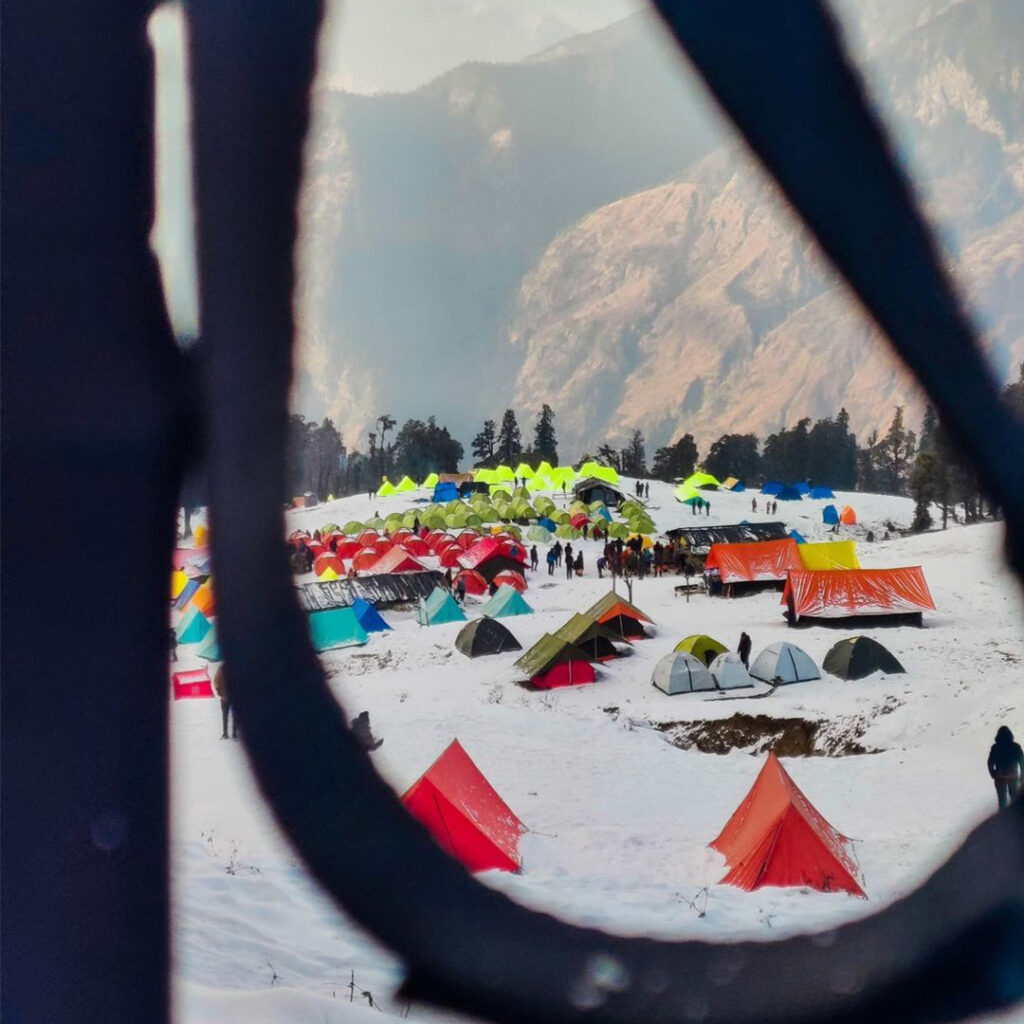
 Choose Your Own Path
Choose Your Own Path The Thrill of the Summit Climb
The Thrill of the Summit Climb






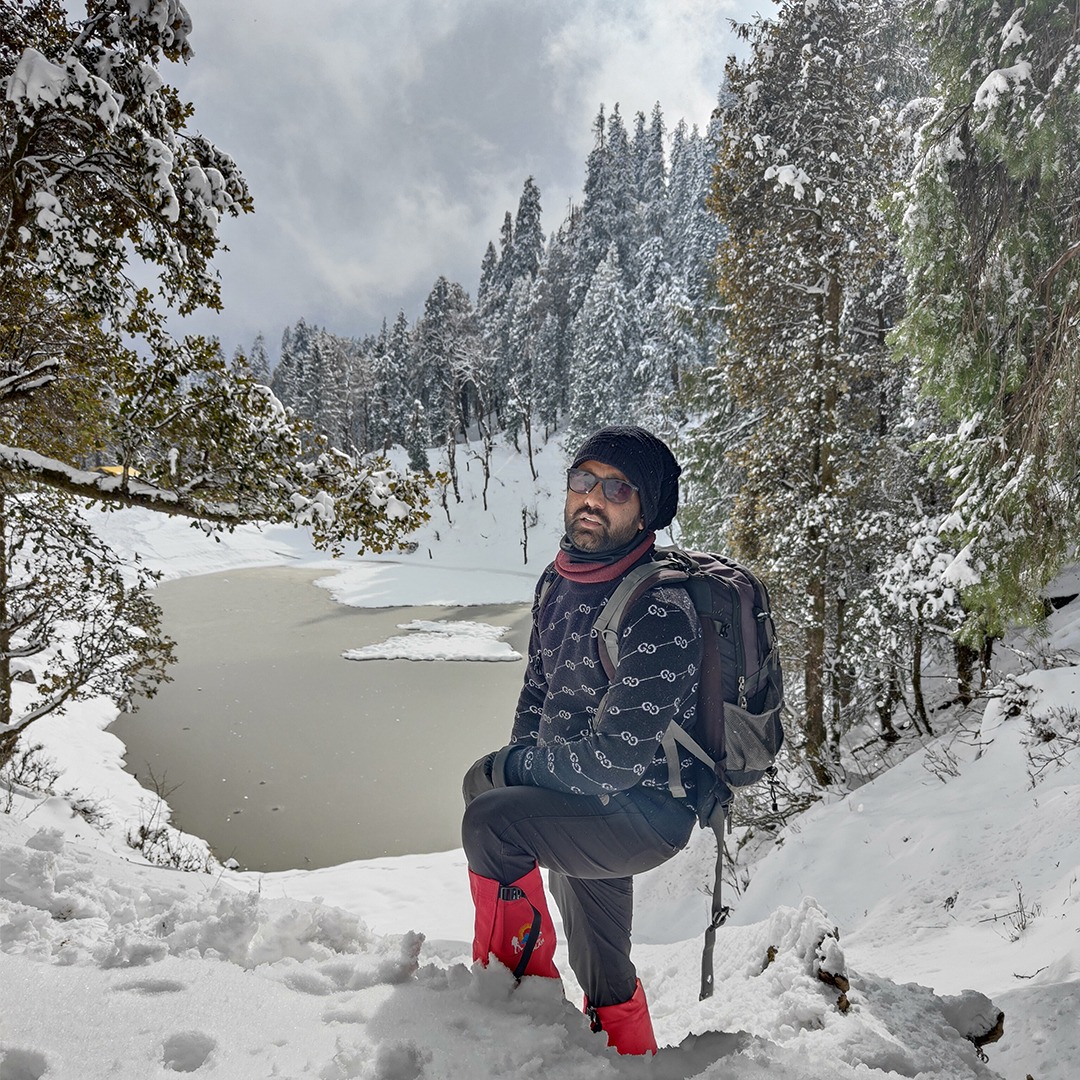
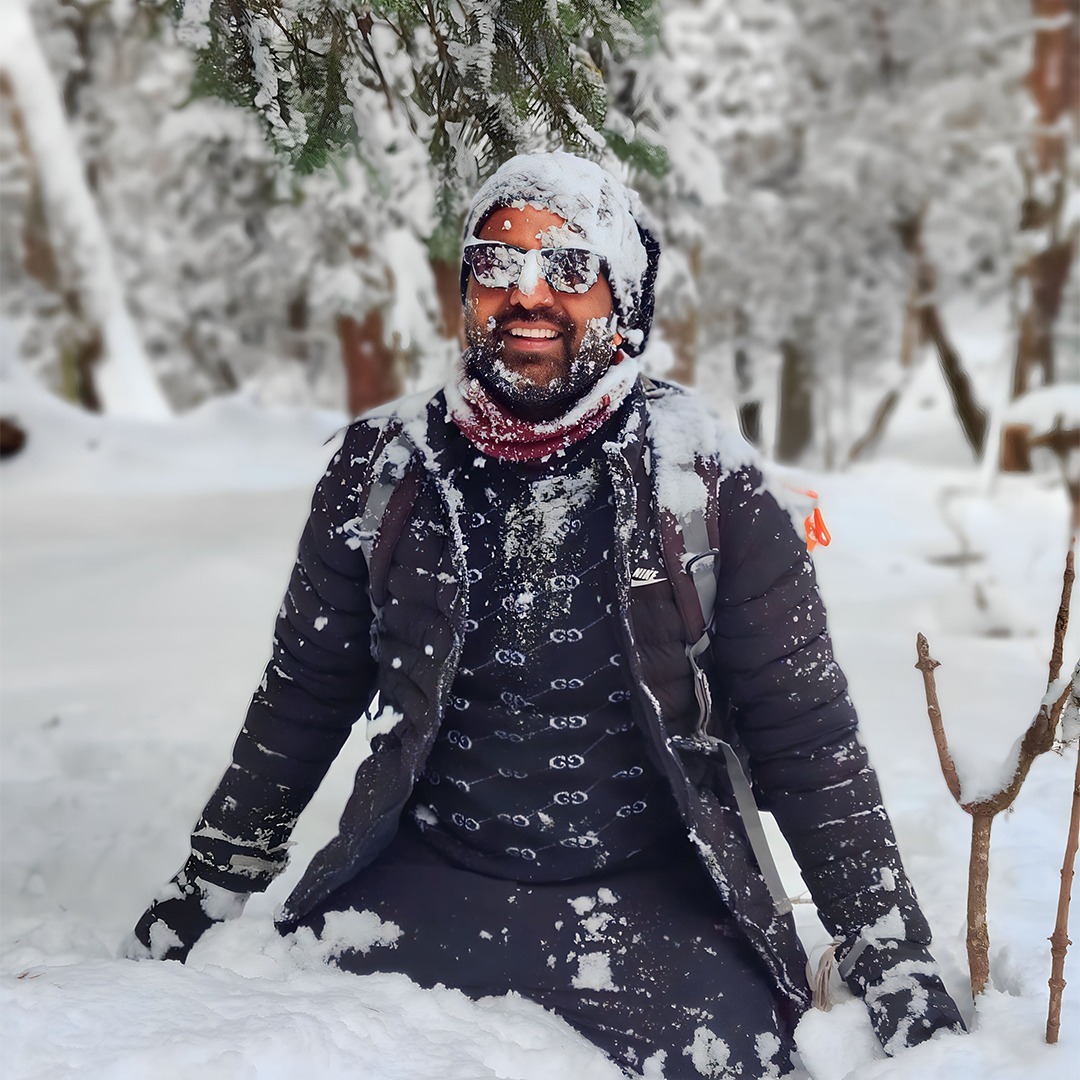
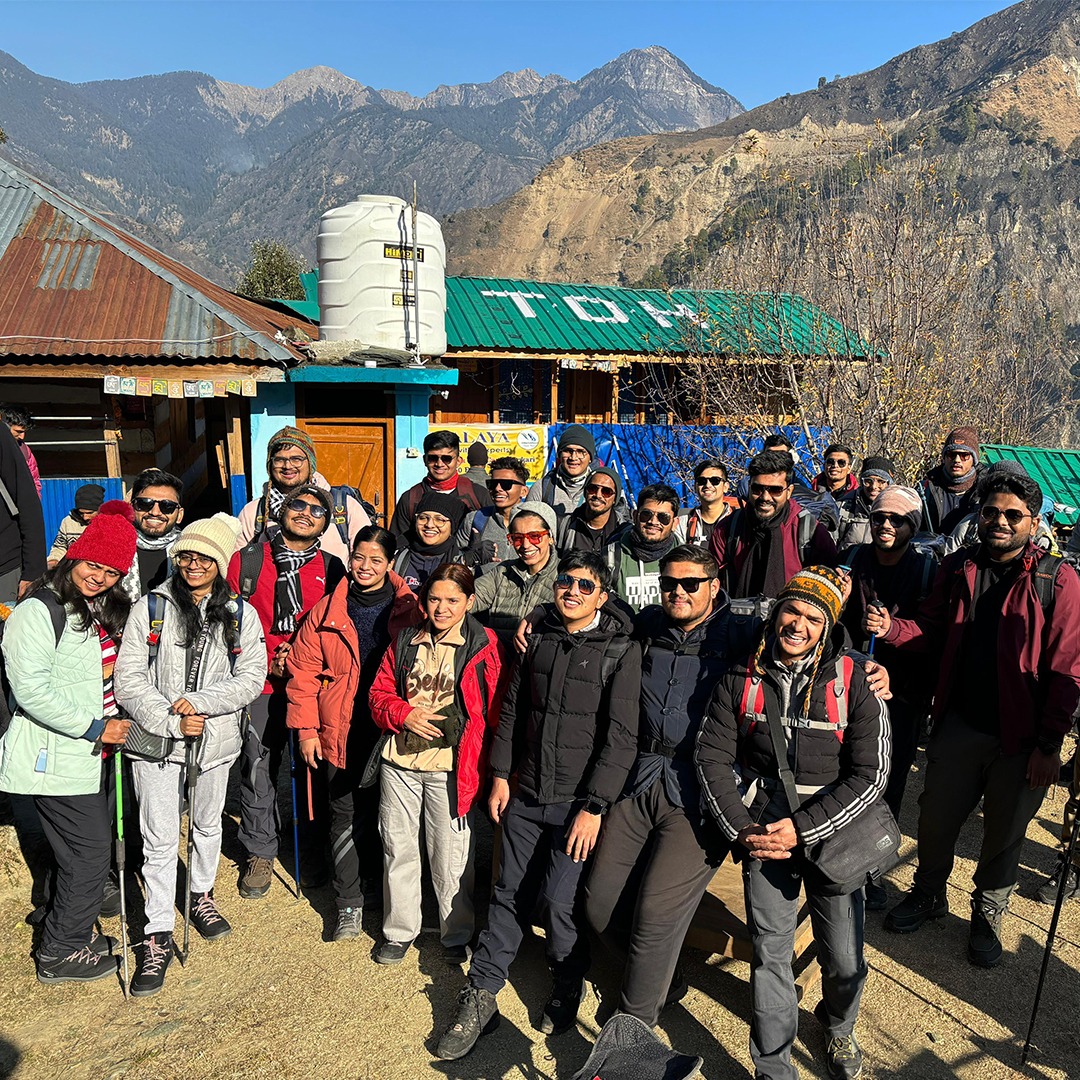
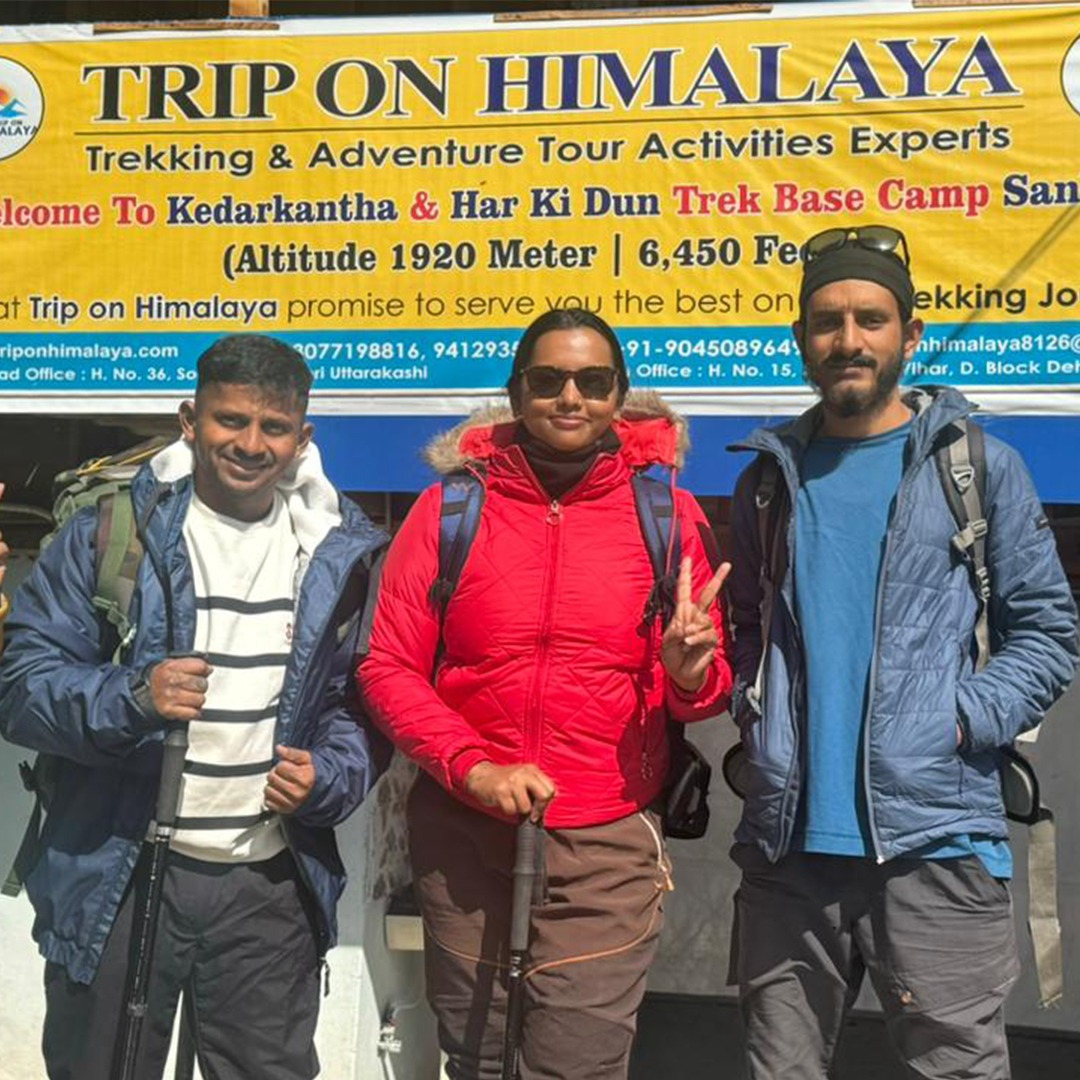
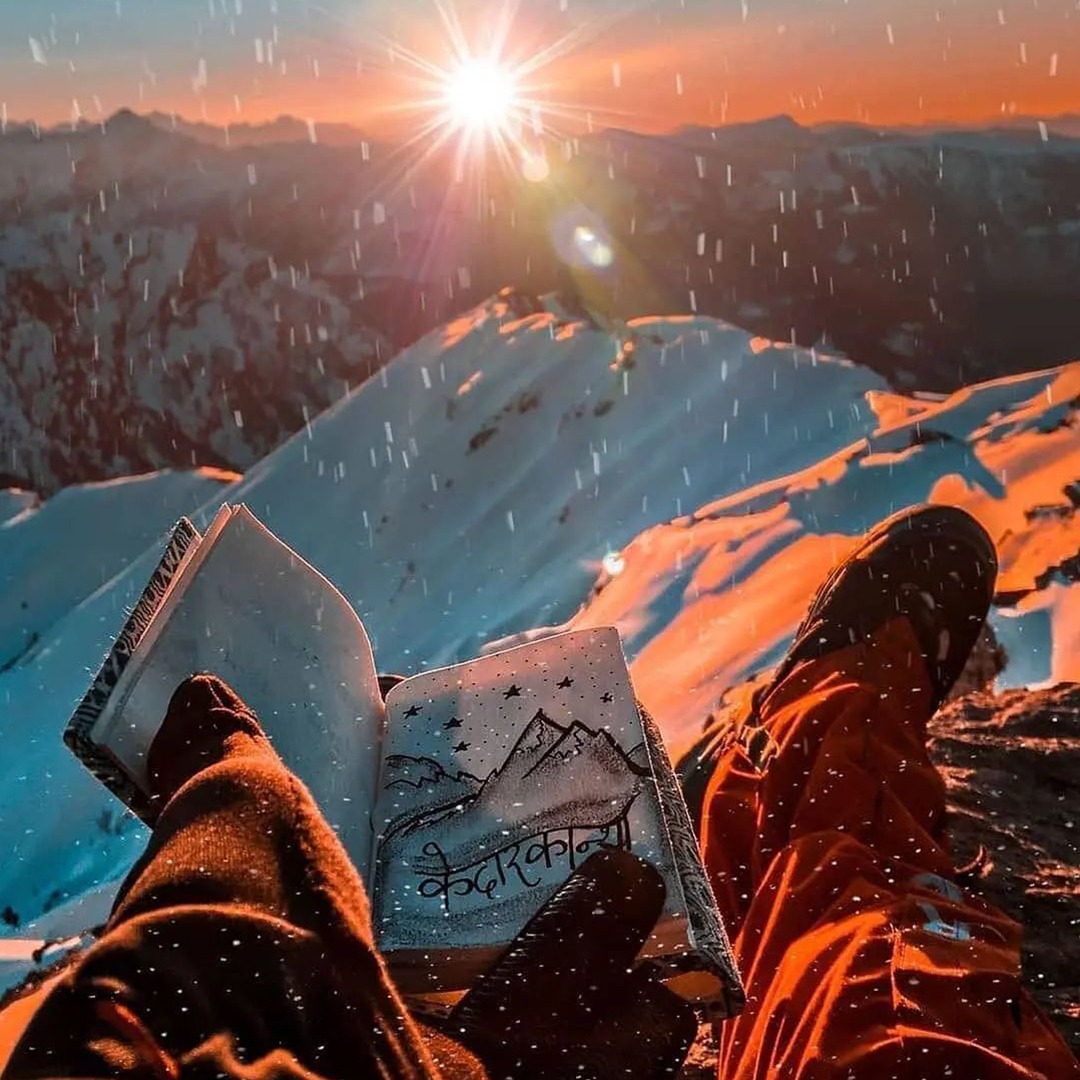
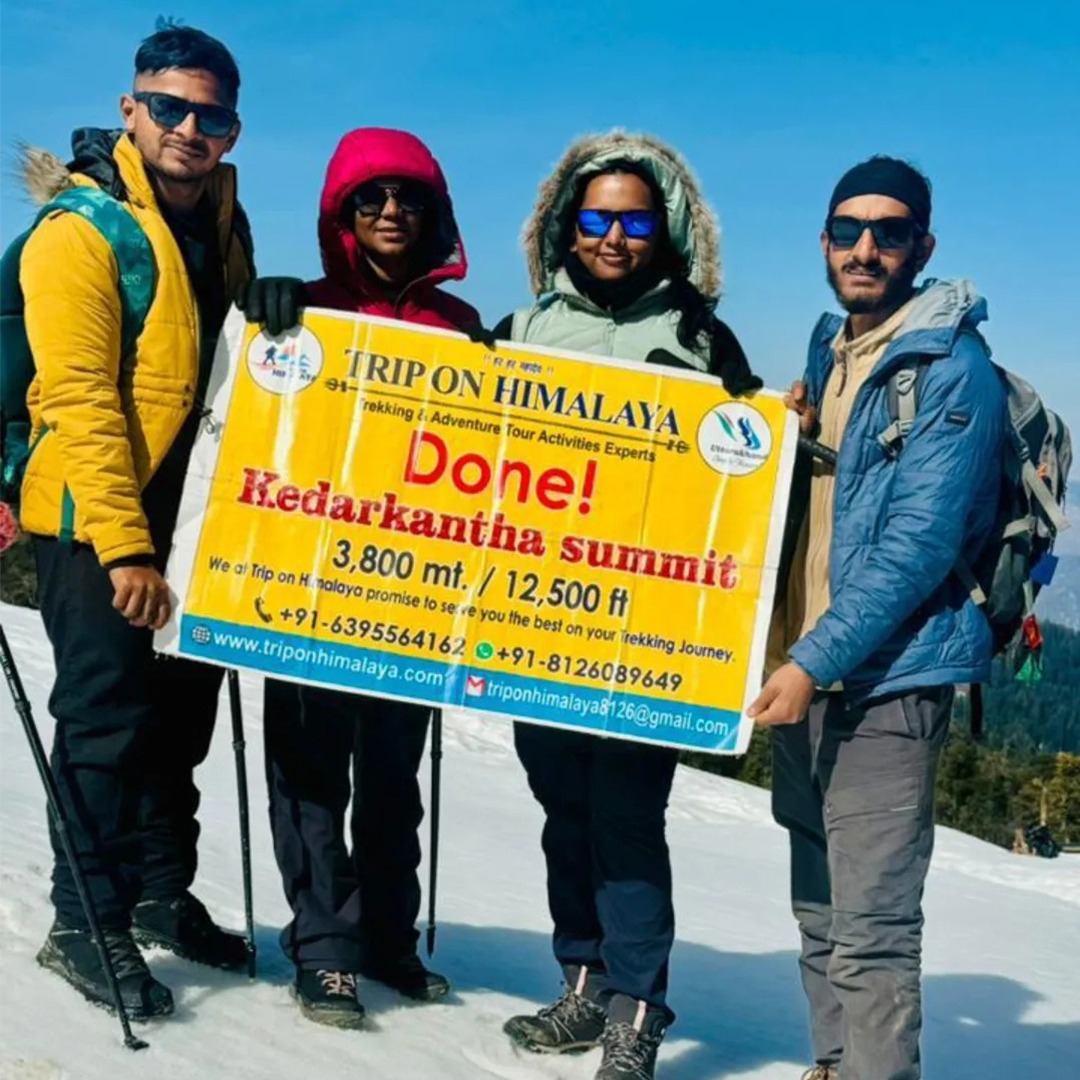
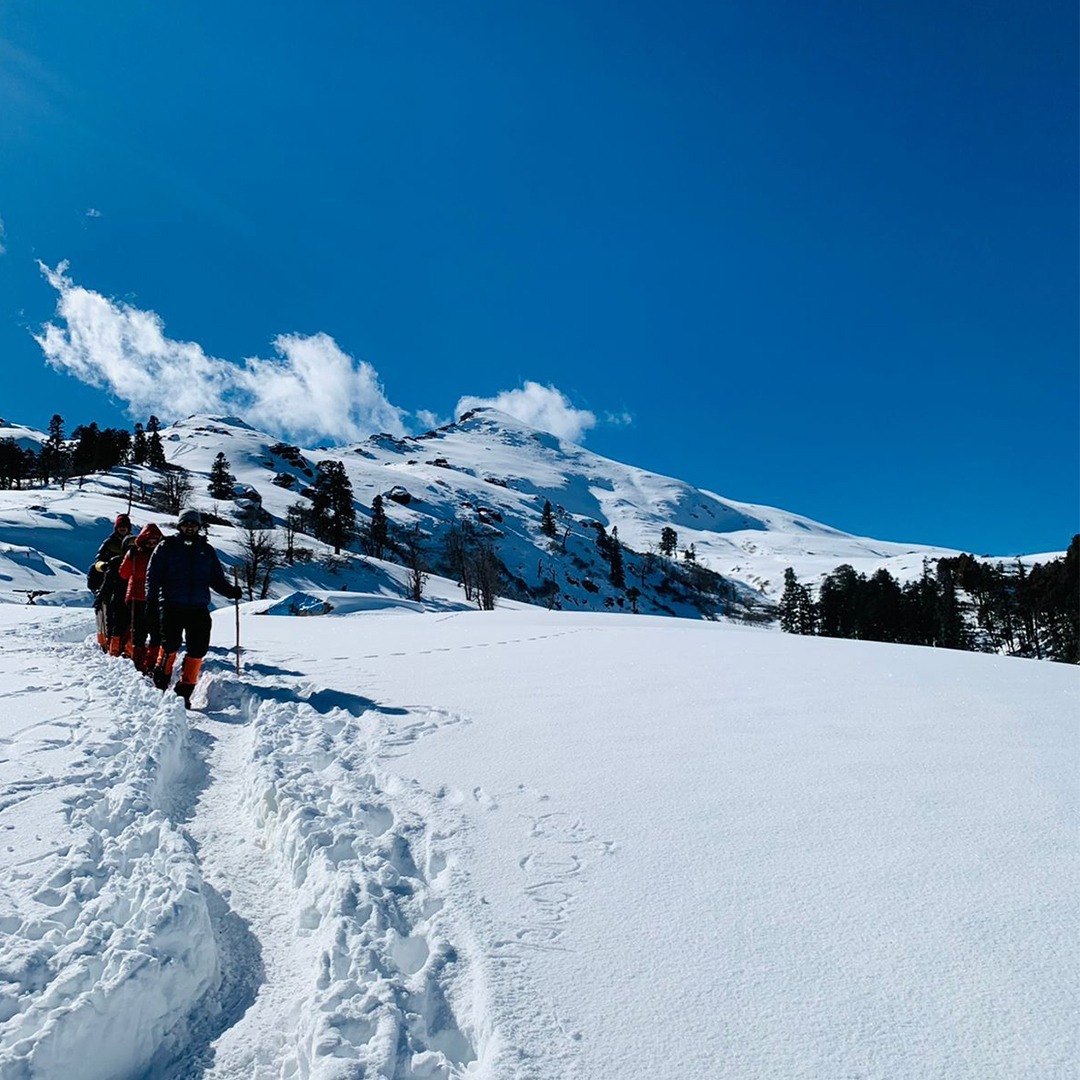
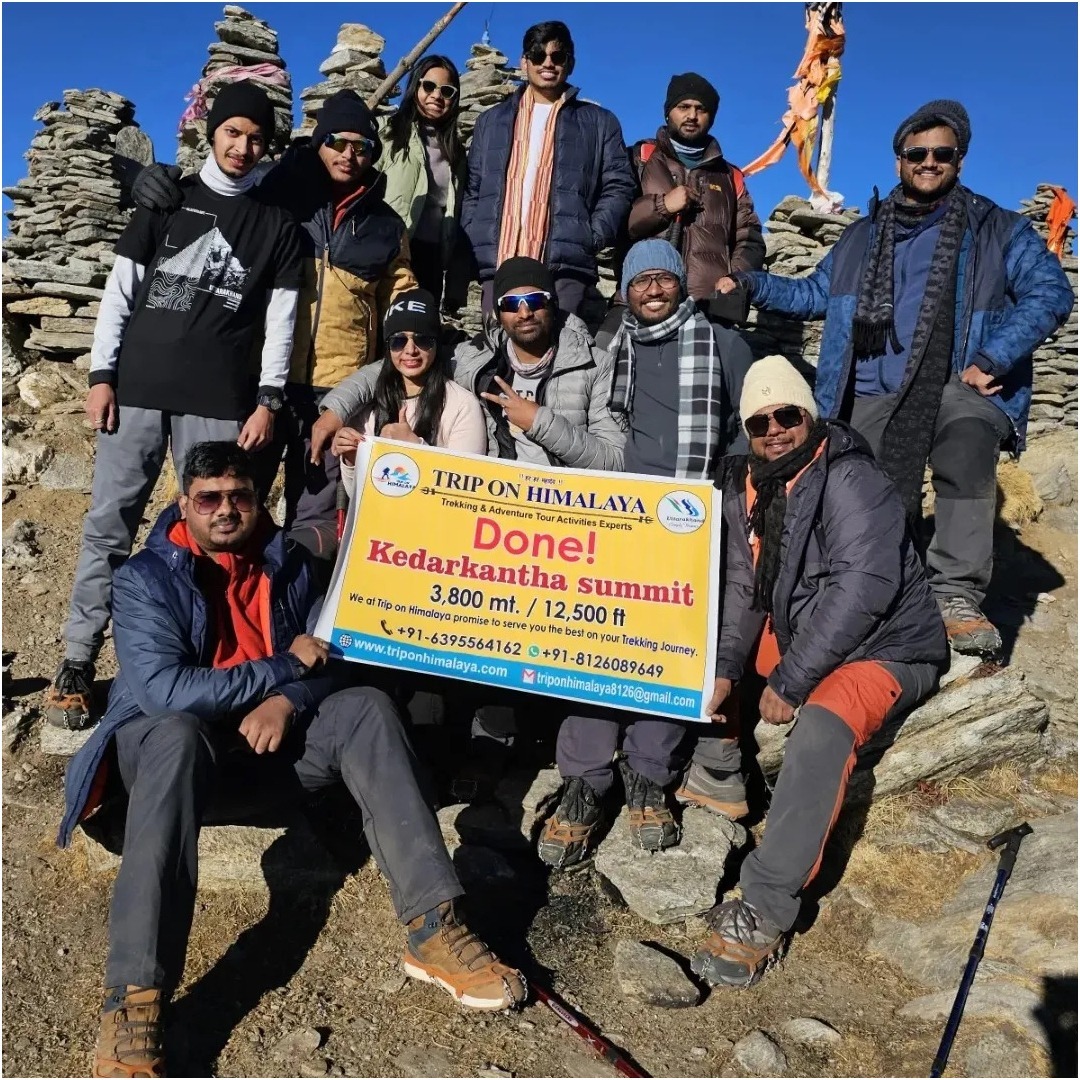
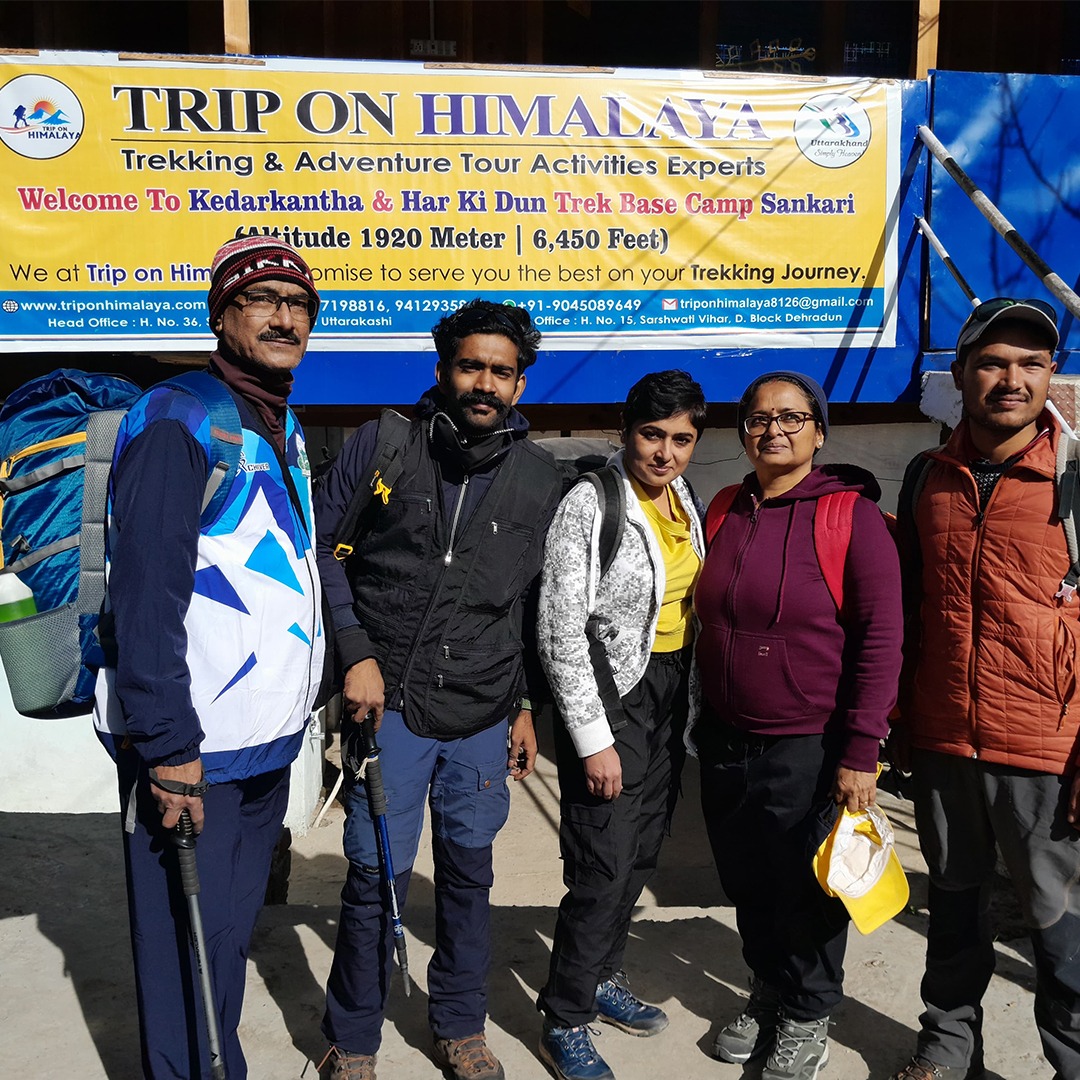
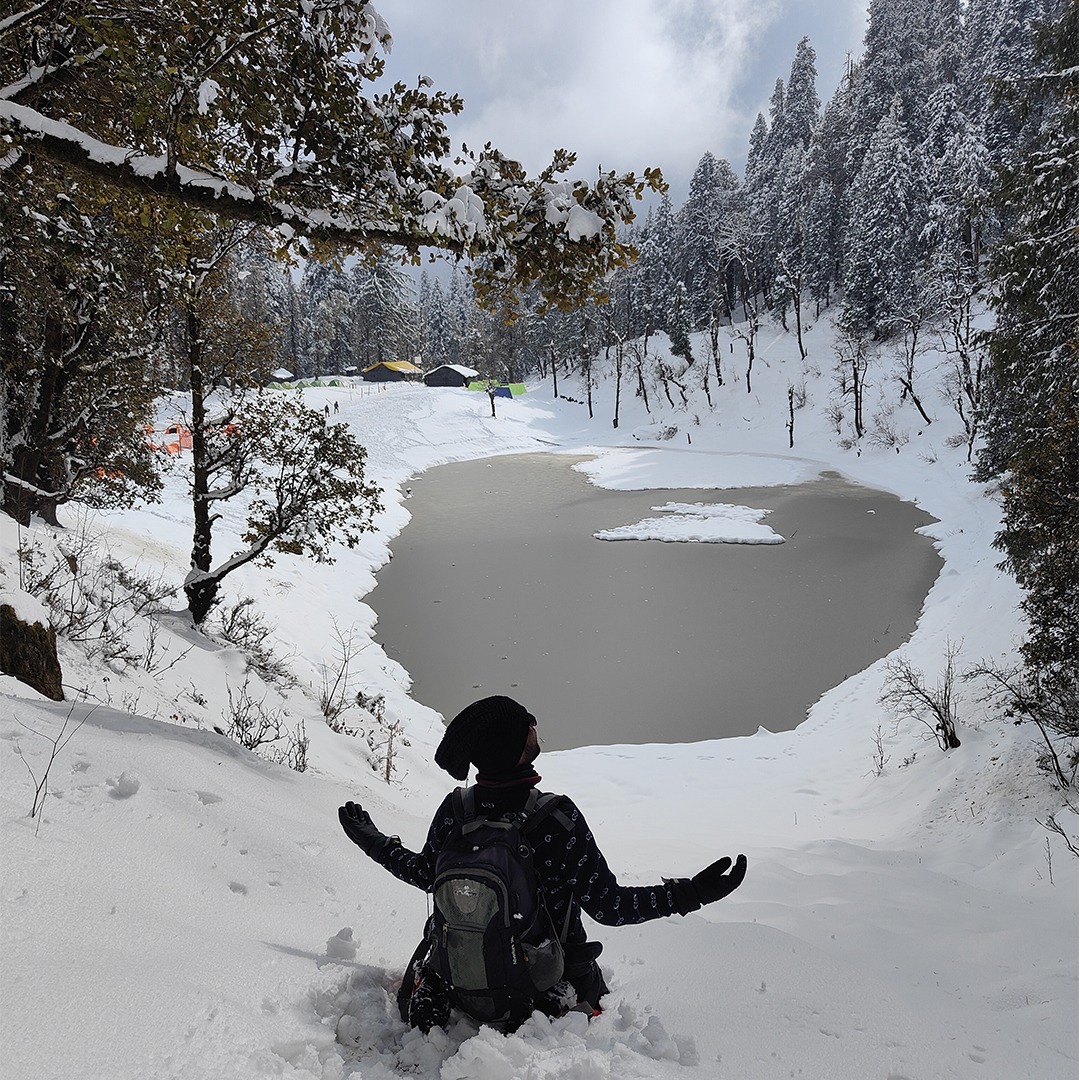
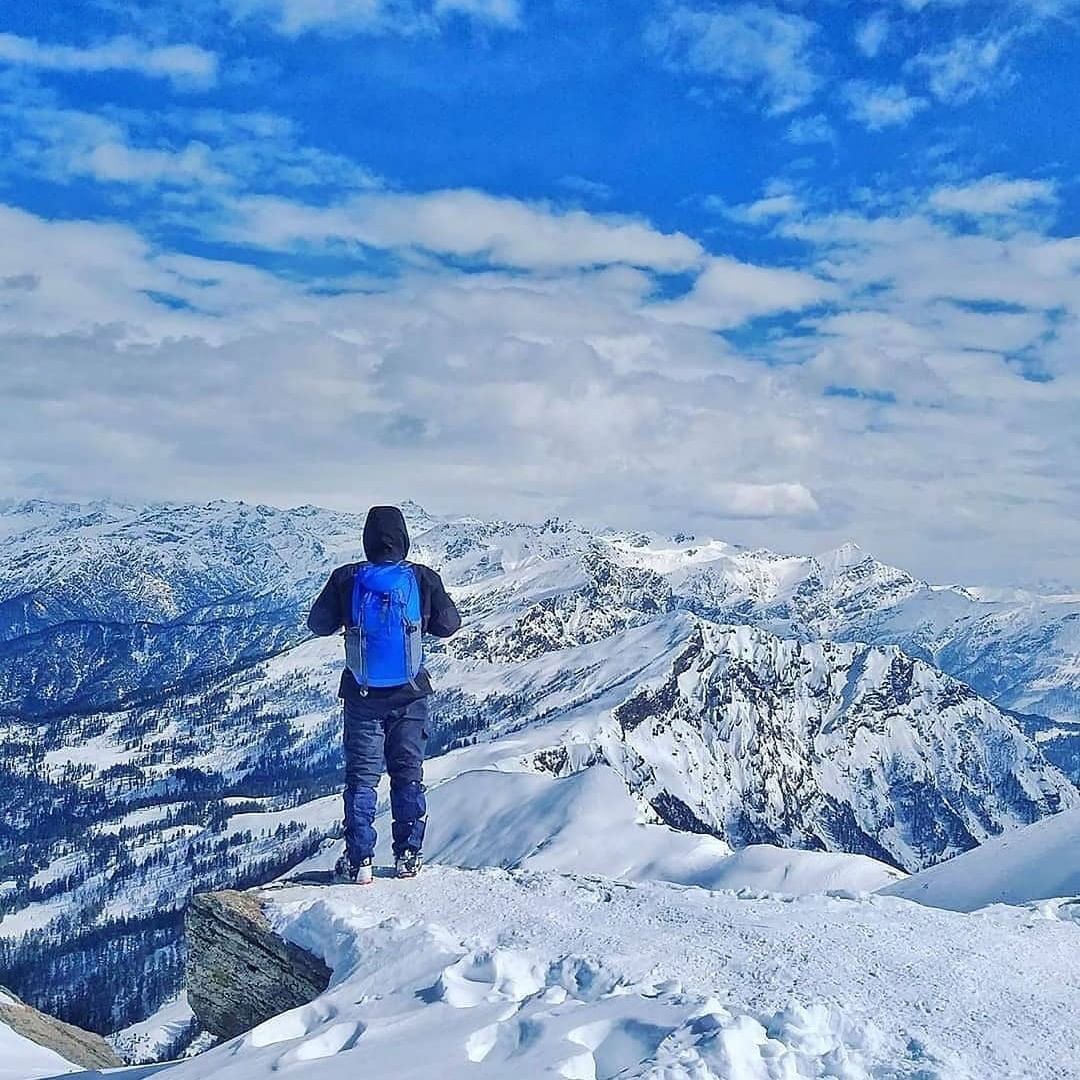
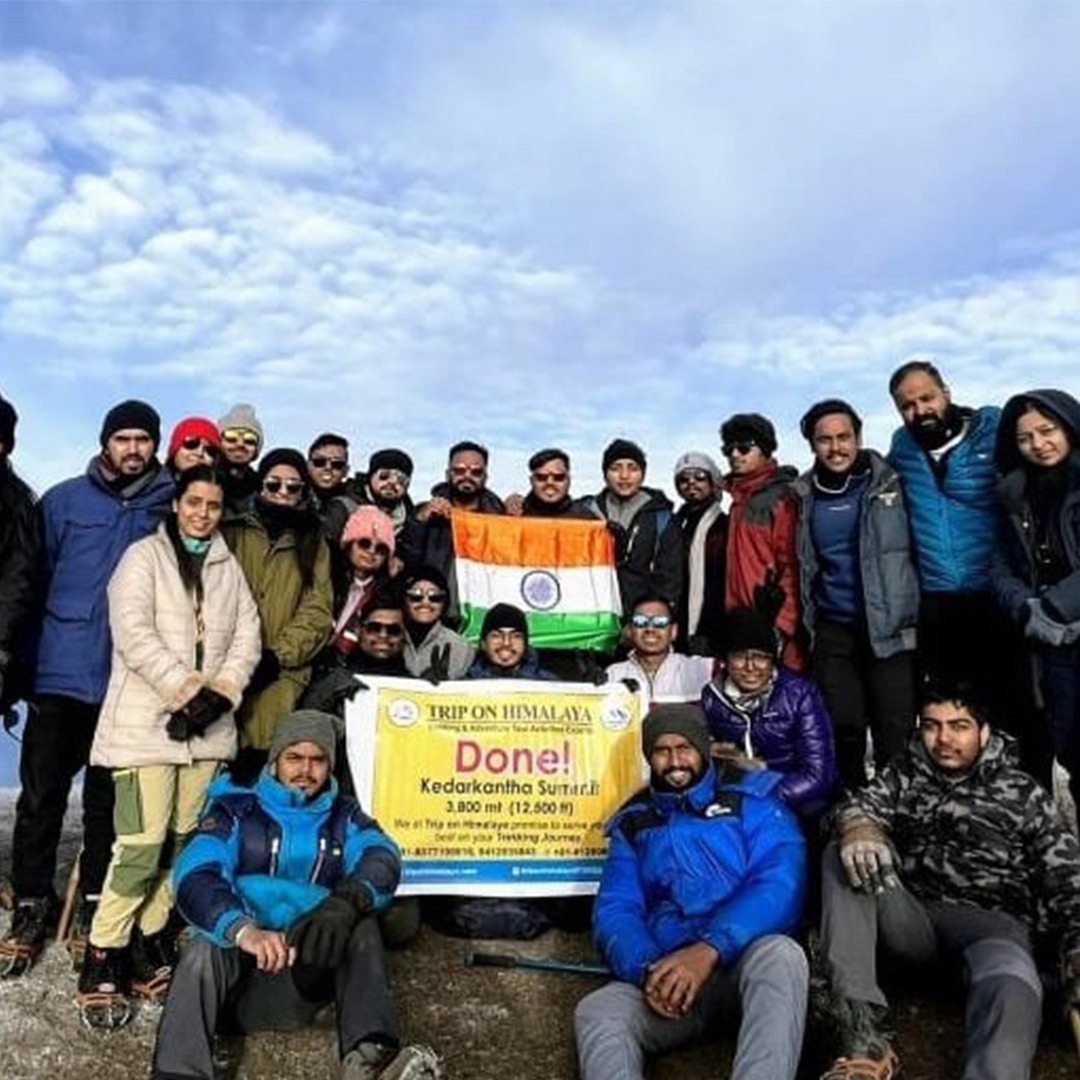
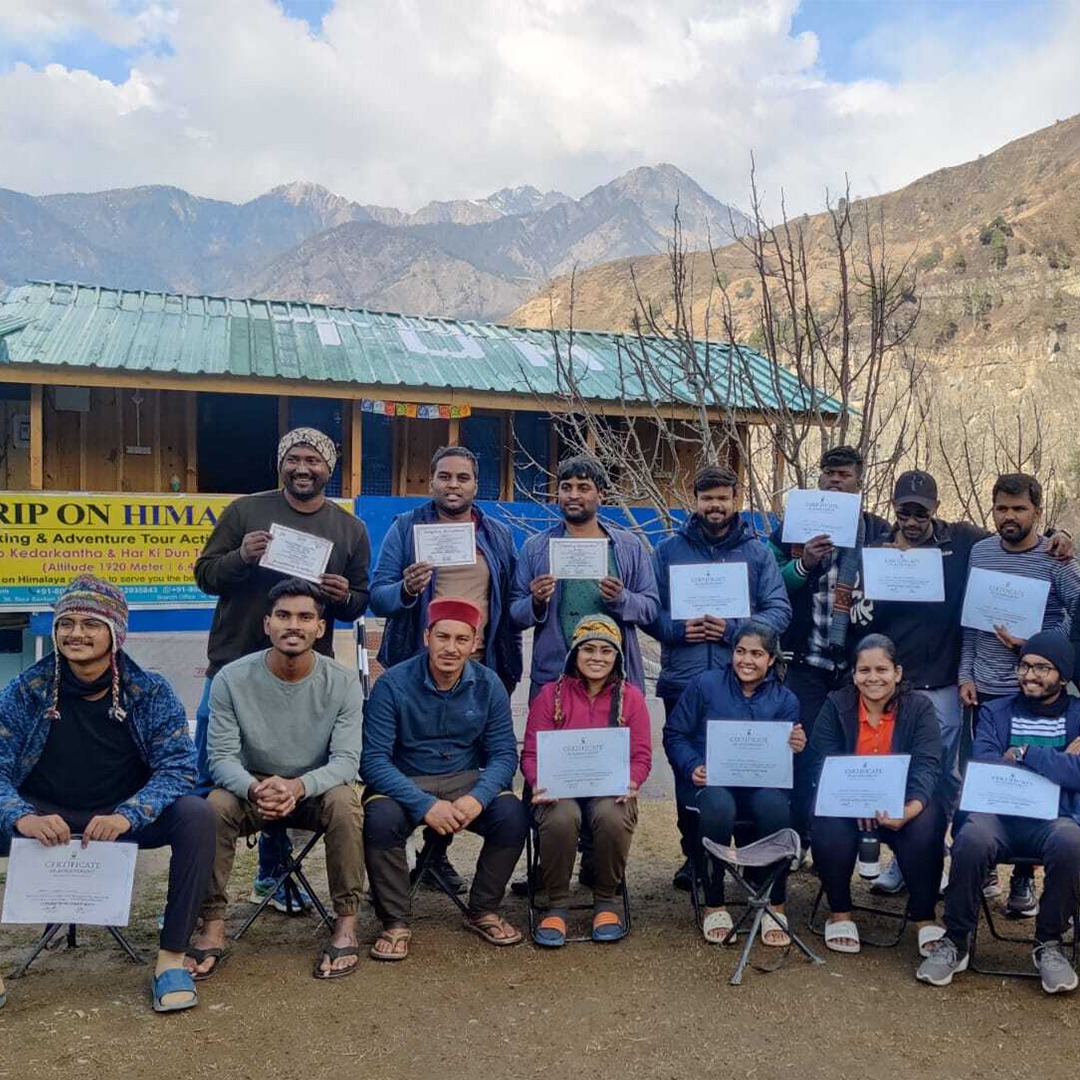
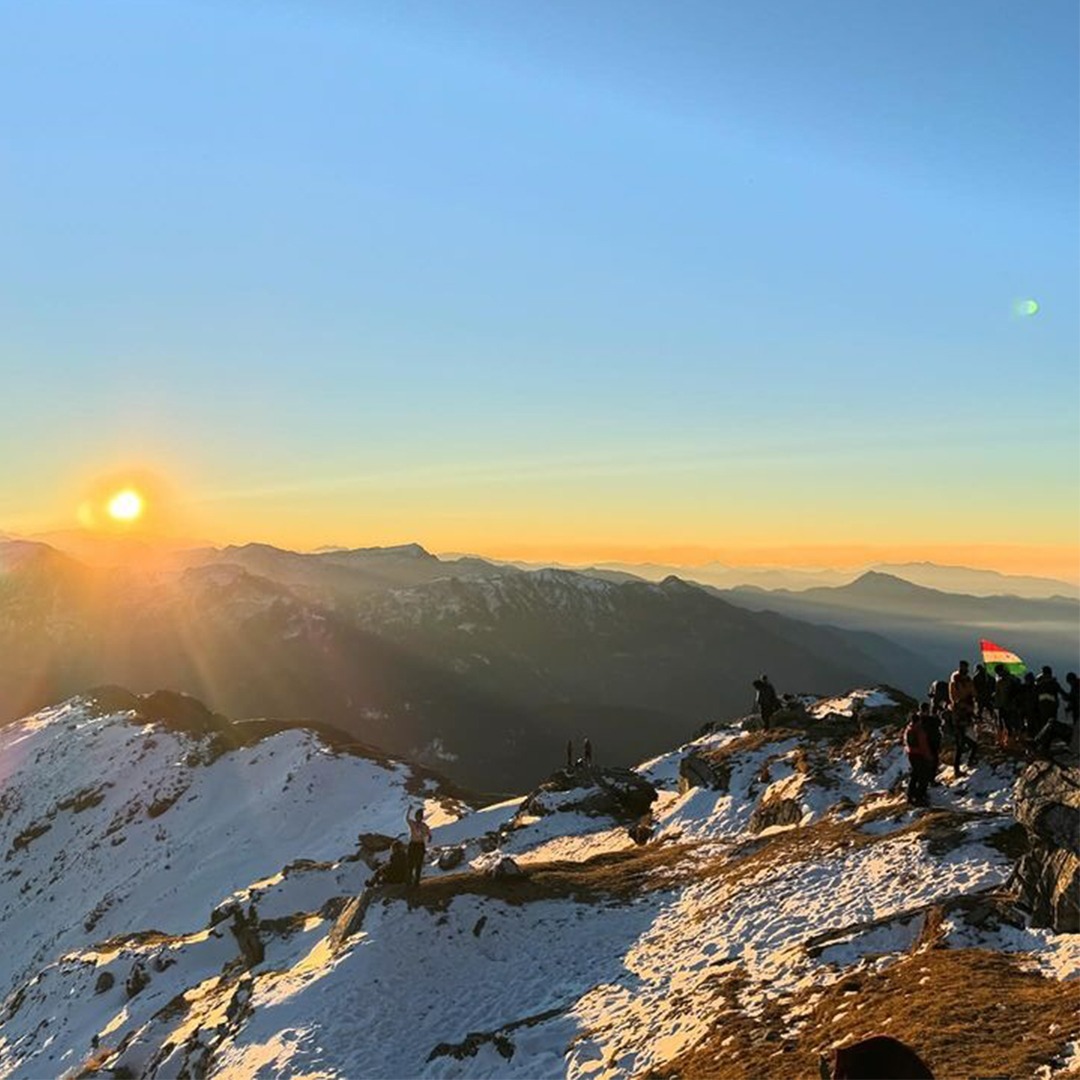
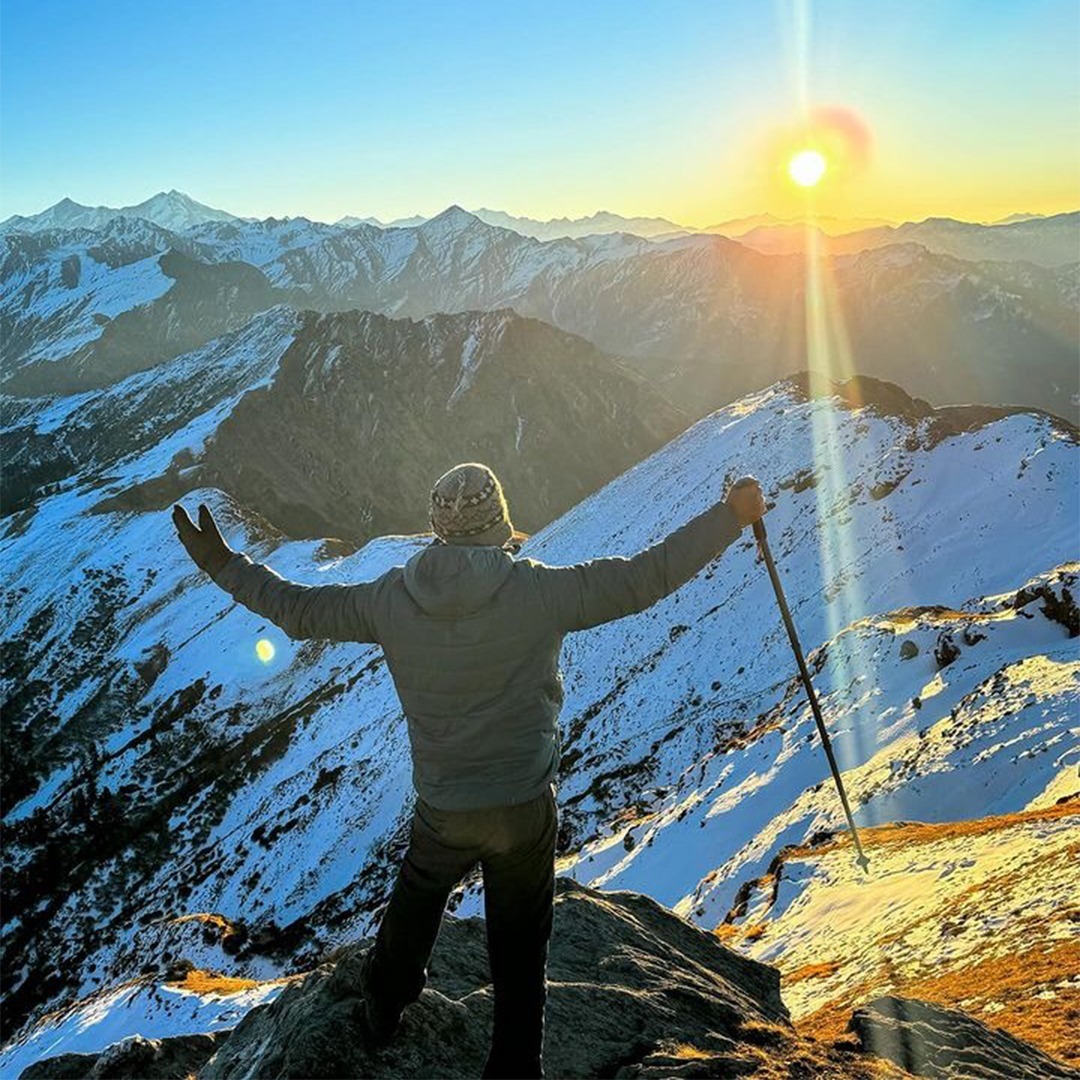
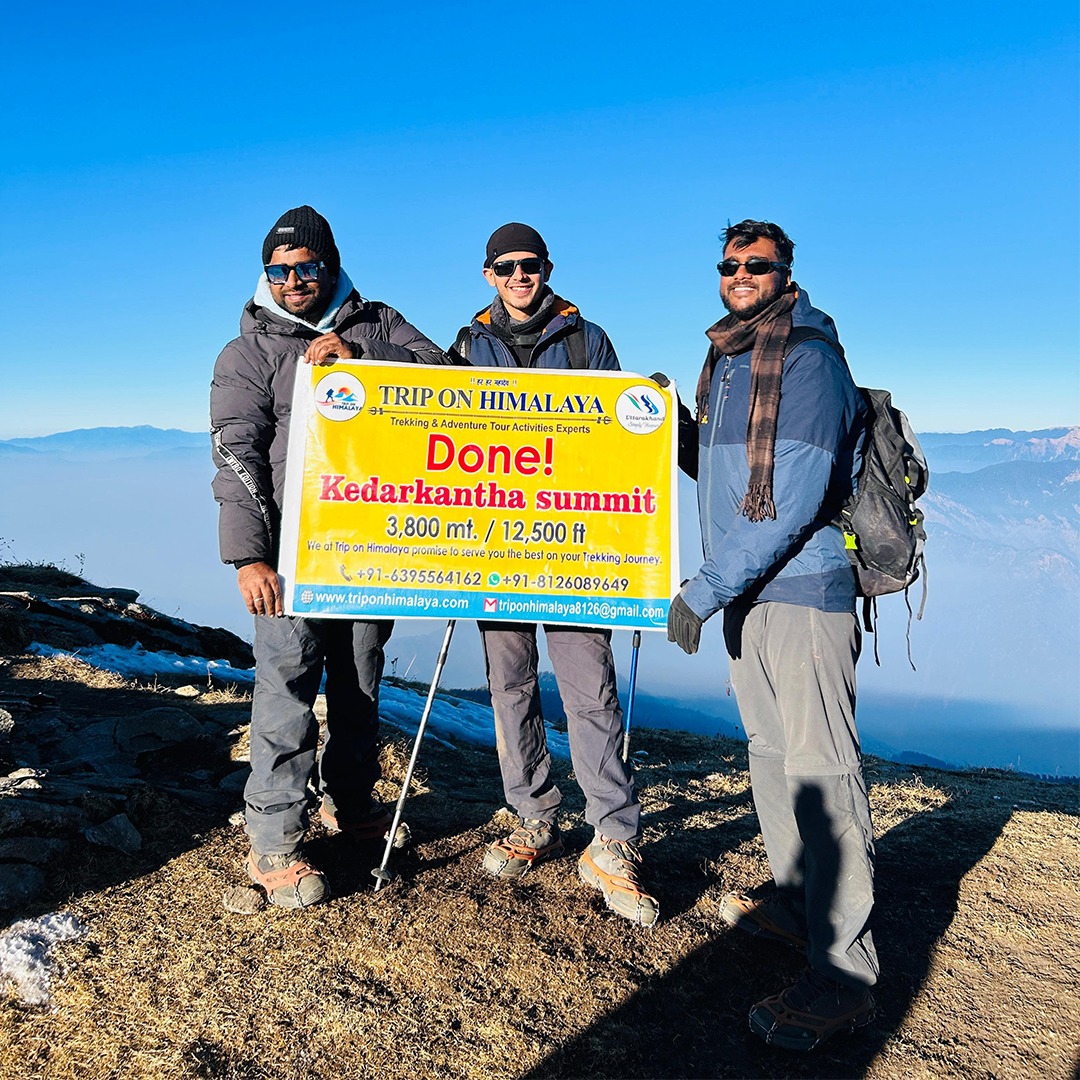
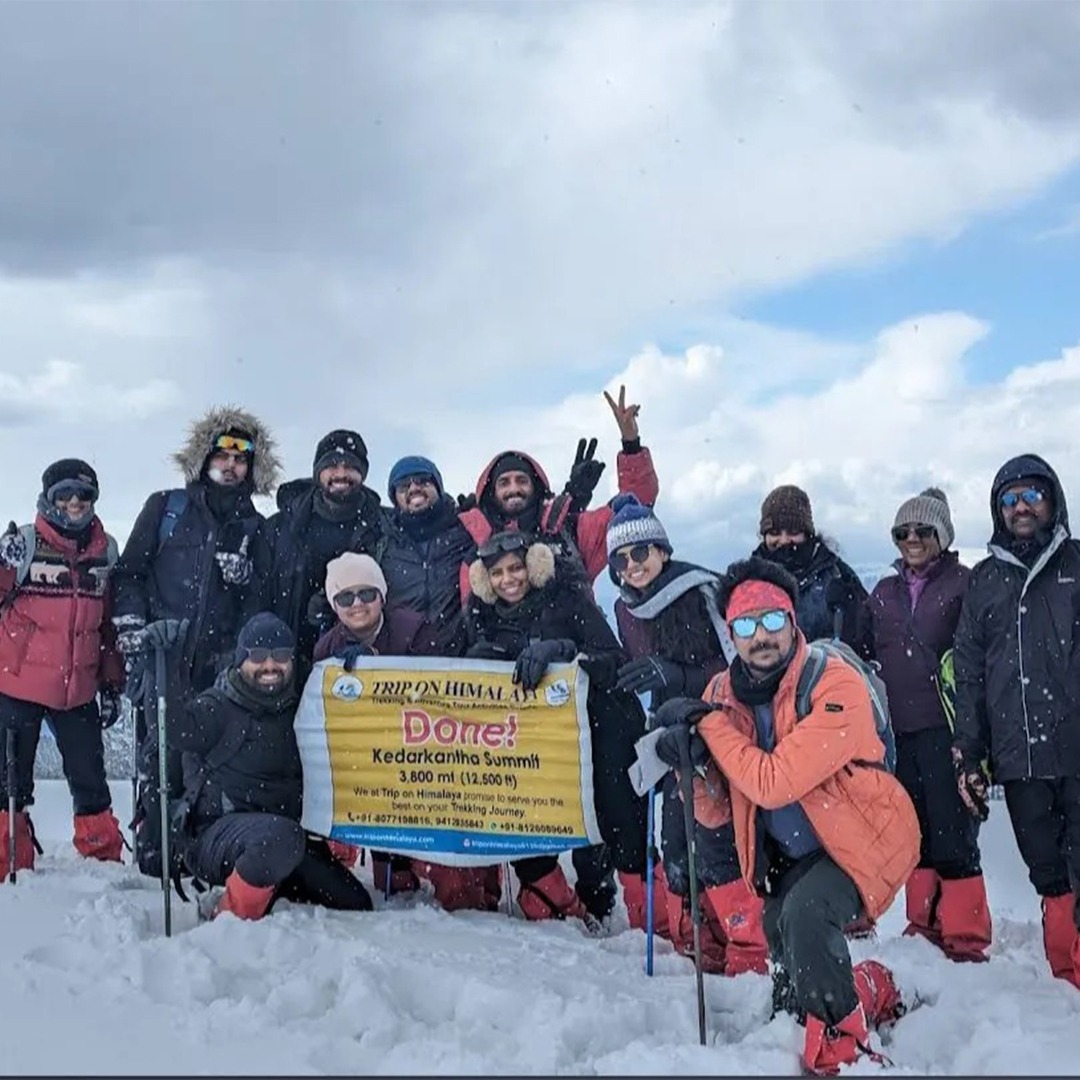
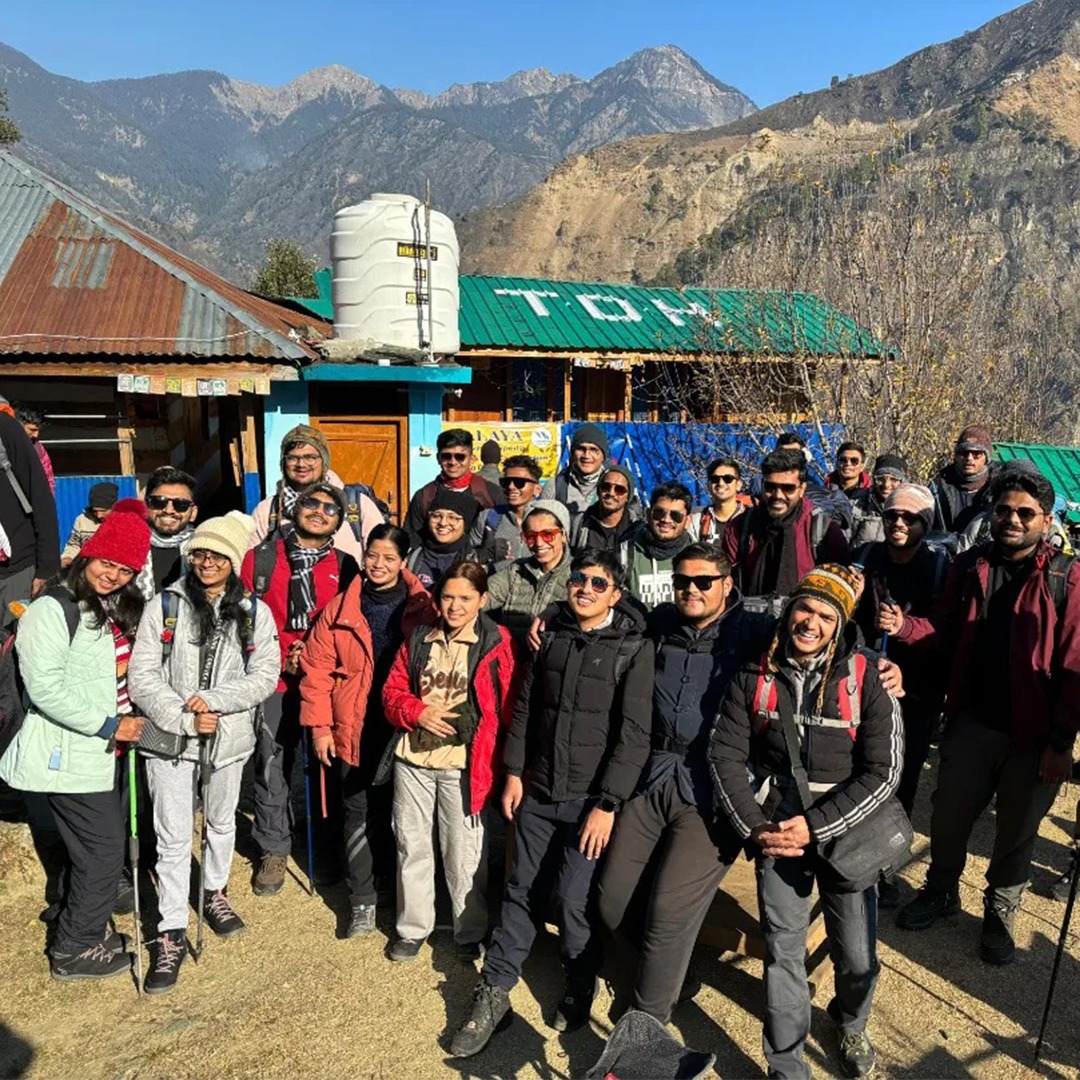
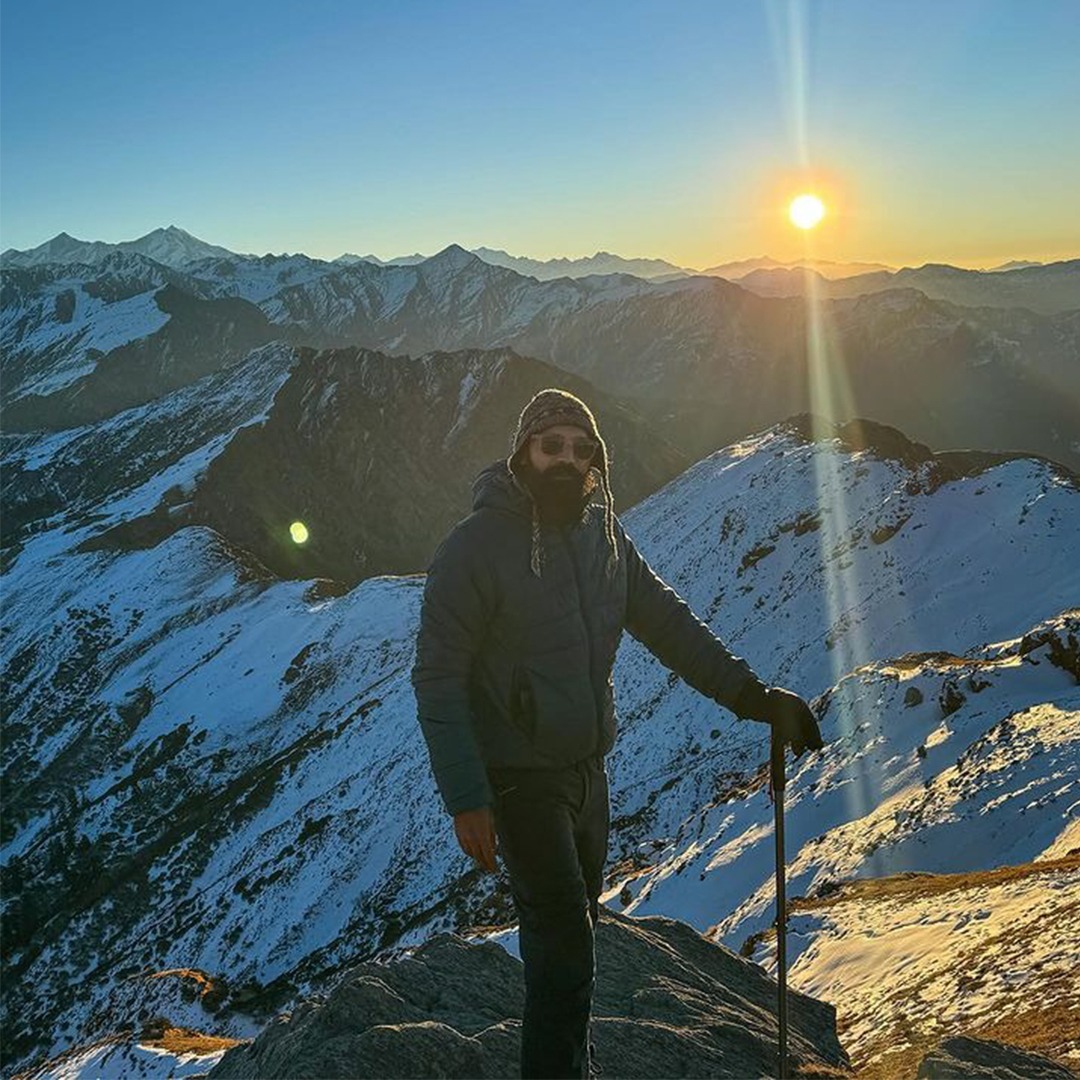
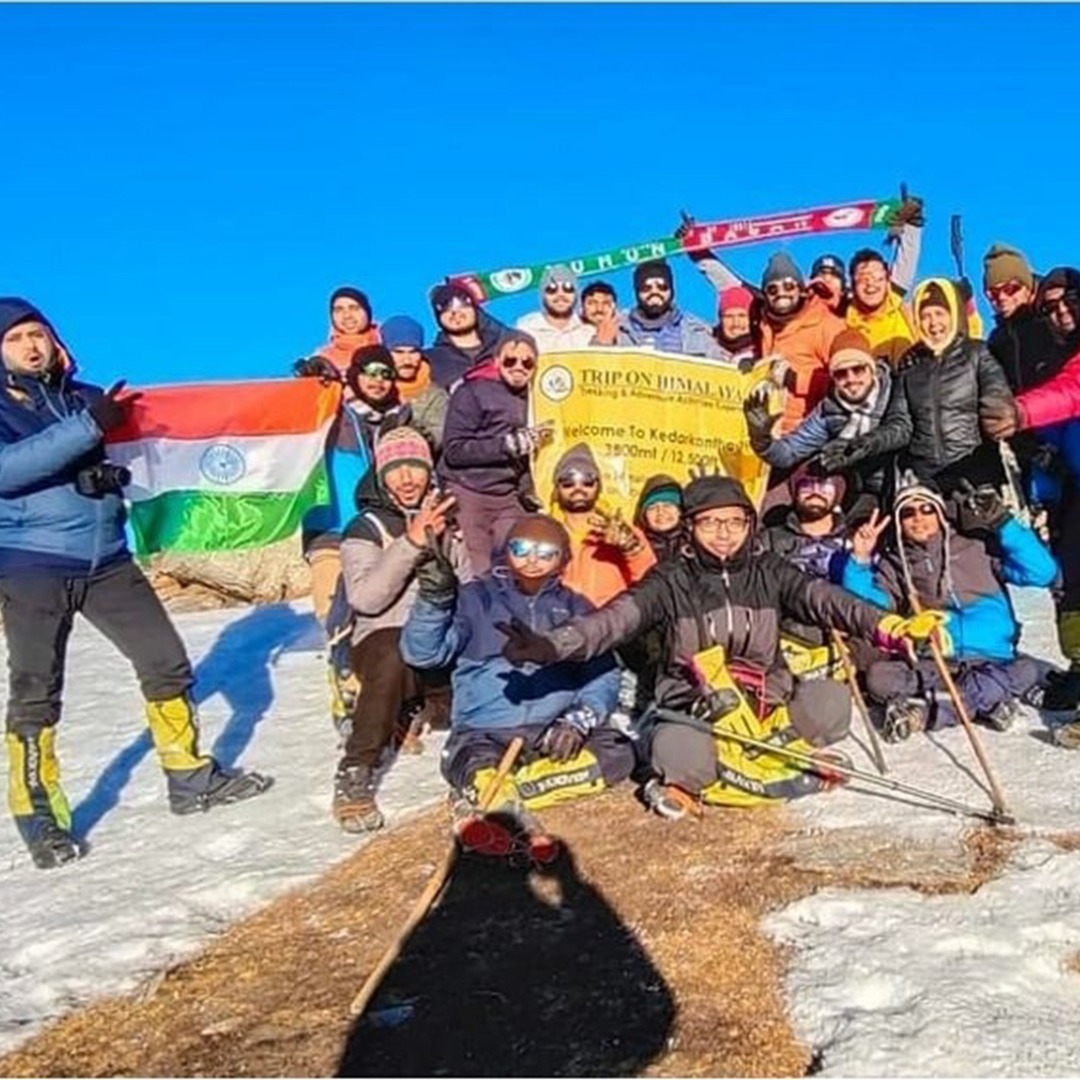

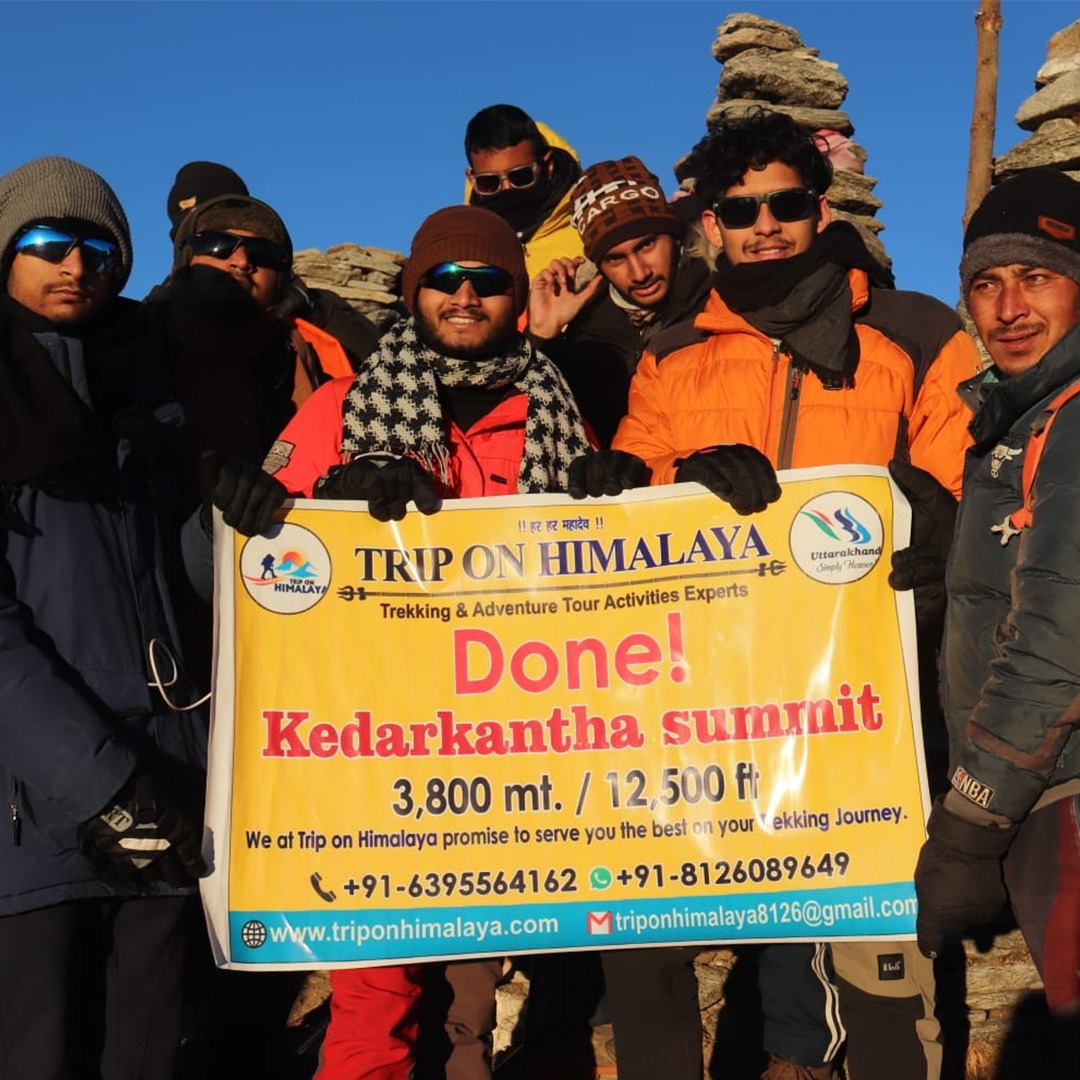
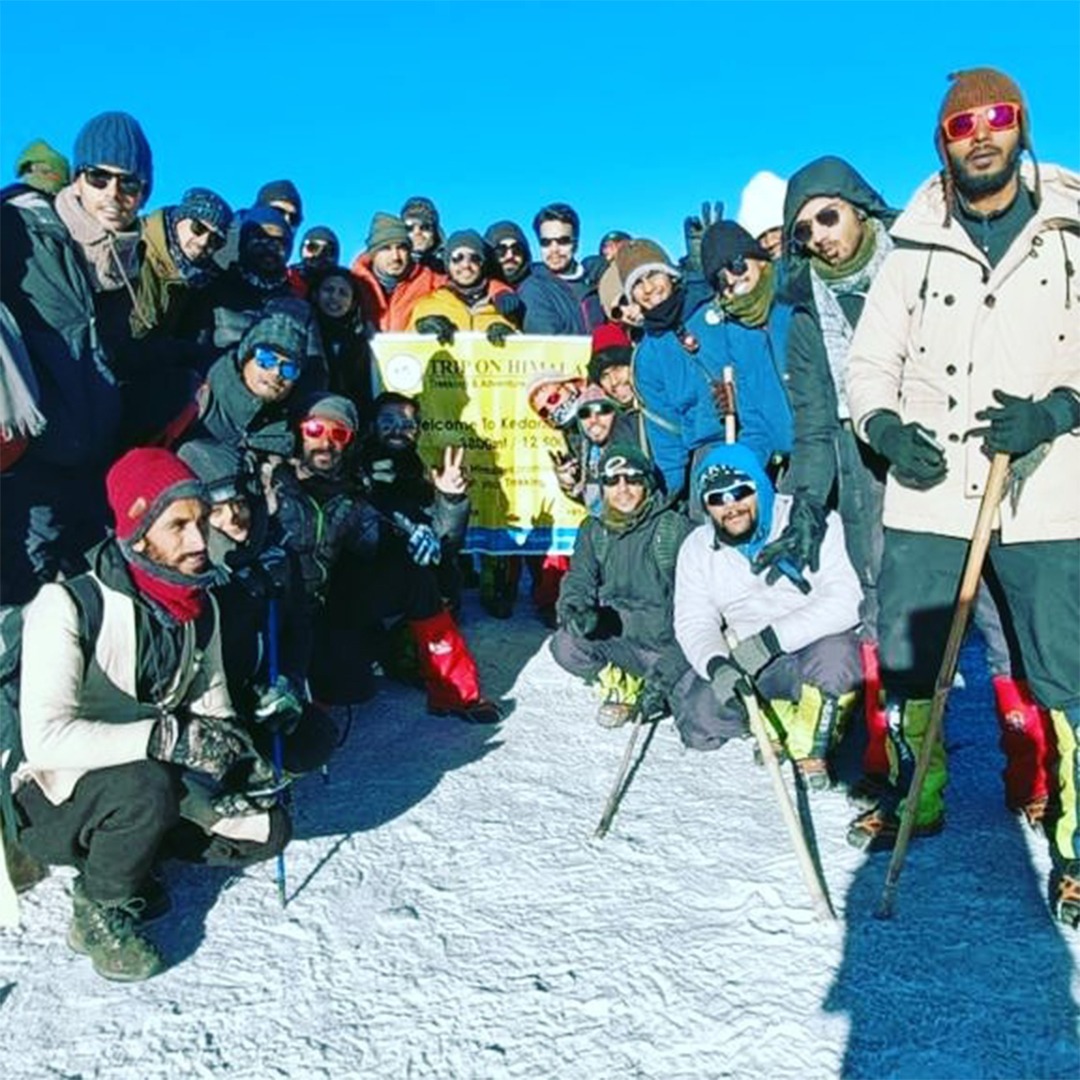

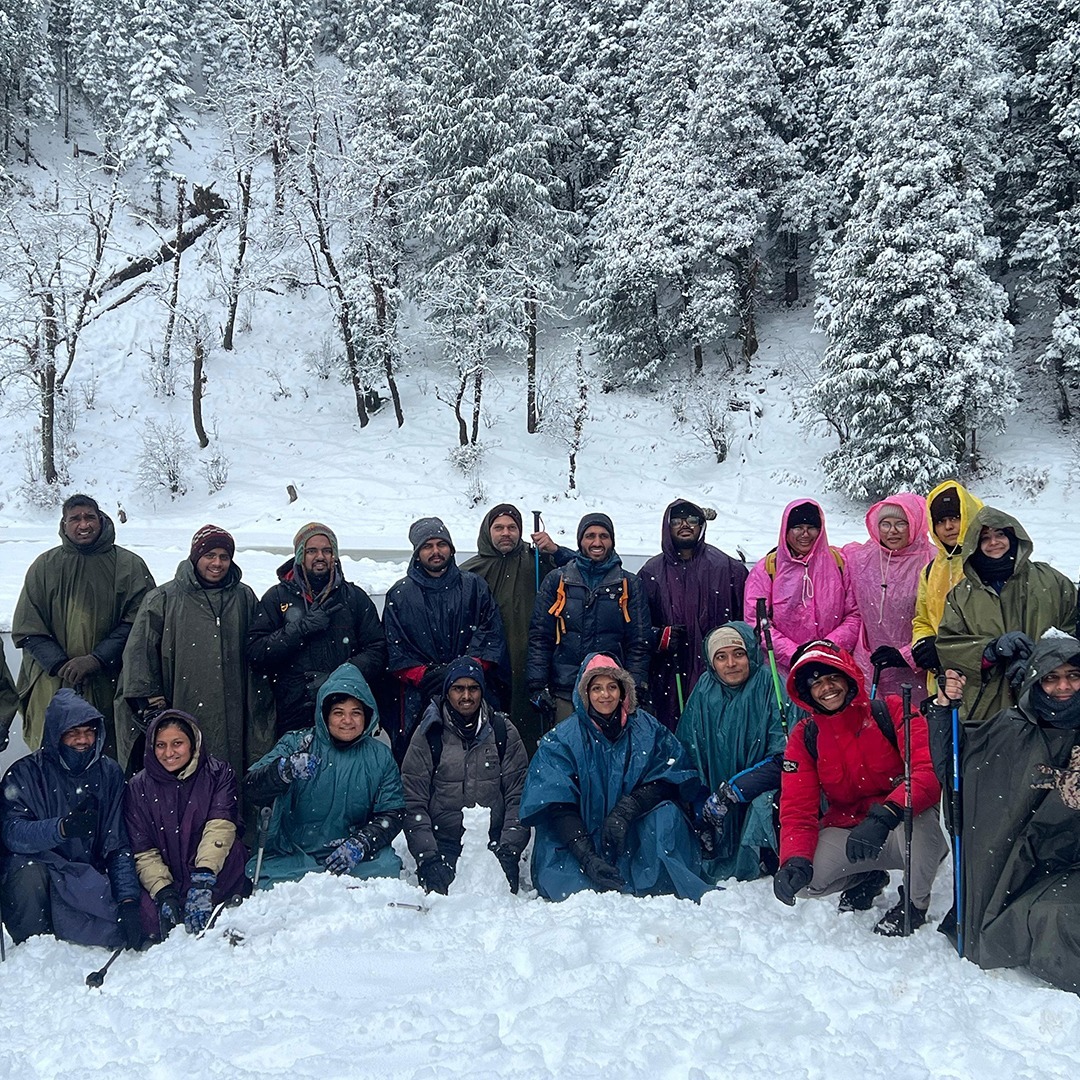
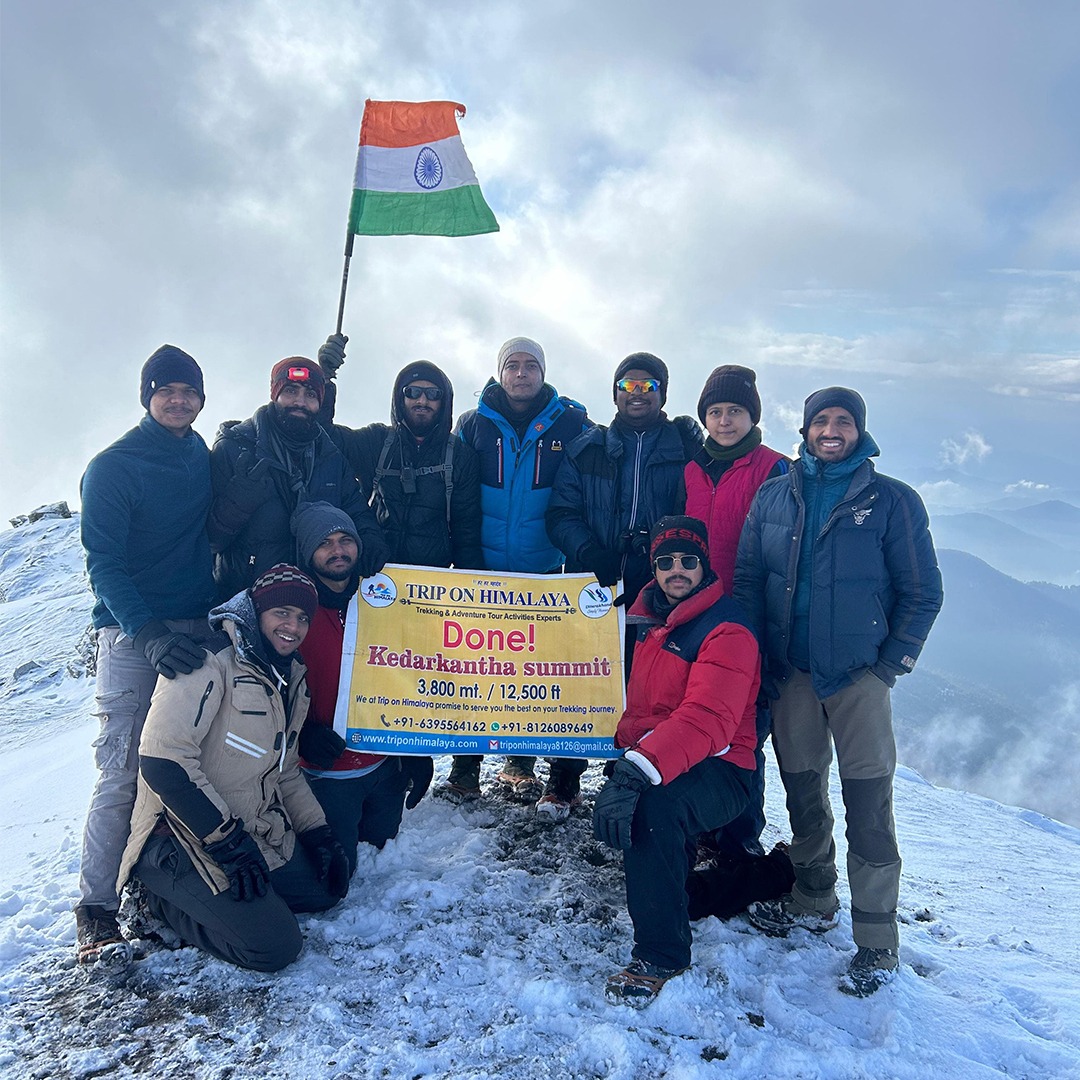

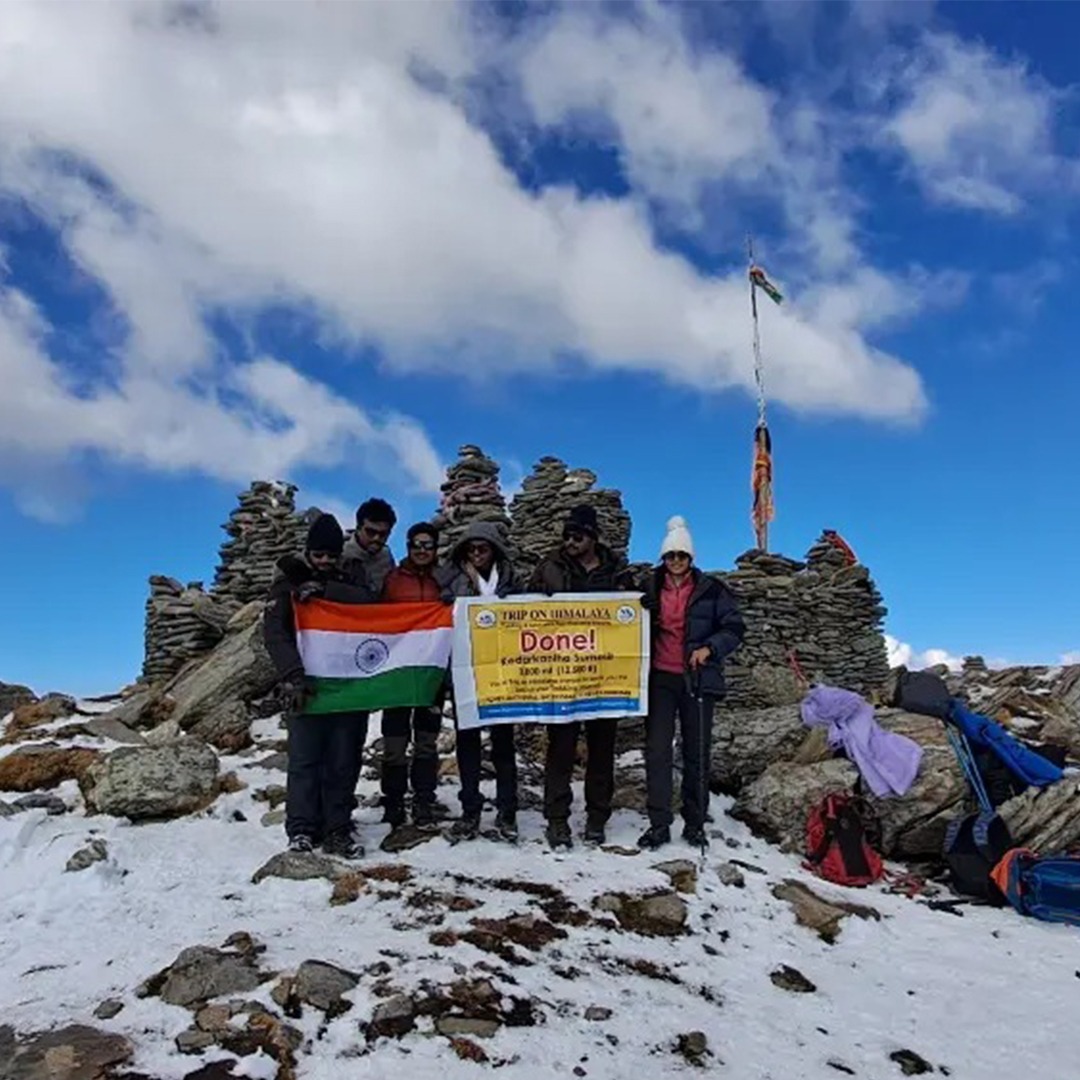
 Offloading Charges:
Offloading Charges: Special Offer – Unlimited Treks!
Special Offer – Unlimited Treks! Important Notes:
Important Notes: Voice-Over (by Anita Rawat)
Voice-Over (by Anita Rawat)

